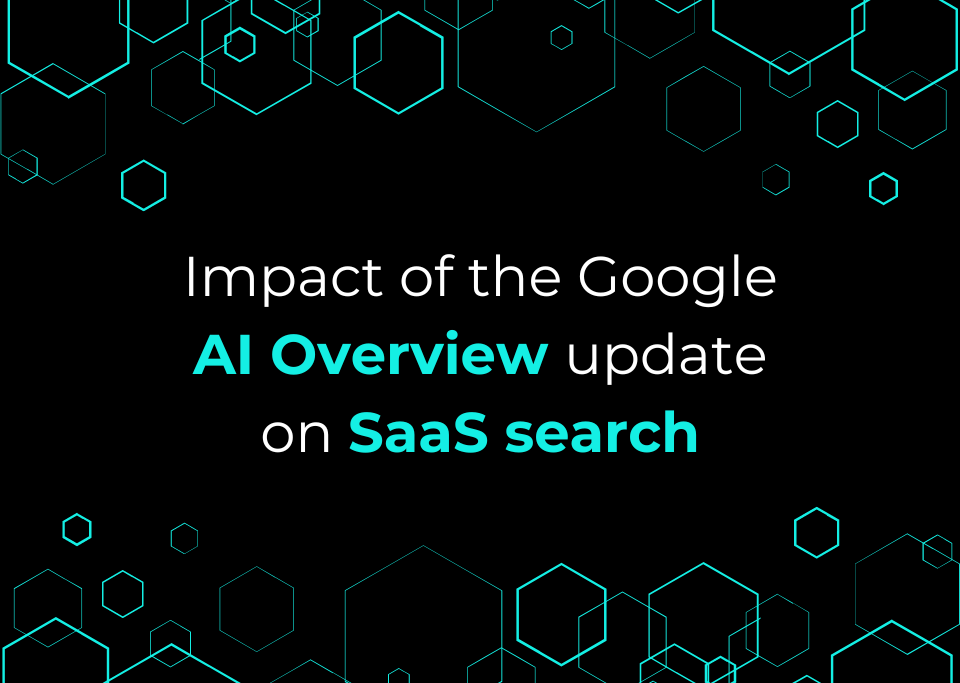Bristol Tech Fest for SaaS Companies
We recently hosted an event for SaaS marketers as part of Bristol Tech Festival. The event was a huge success with over 80 SaaS marketers attending, with presentations on inbound lead generation and analytics for SaaS companies, and a panel discussion with Brightpearl, BookingLive, and Natwest.
Book a Consultation
WORKSHOP TRANSCRIPT
INTRODUCTION BY JACK THOMPSON
[00:00:01] Welcome to the Accelerate session on how to rapidly scale your digital marketing. It’s part of the wider Bristol Technology Festival if you didn’t know. This is an individual event. There are 42 other events happening across the week. We’re very pleased to be involved. And we’re very happy that all of you have joined us this morning.
I’m Jack Thompson –– I’m Commercial Director at Accelerate. And I’ll be, sort of, comparing today. I’m not actually presenting. I’ll be here, keeping everything in check.
First of all, some classic housekeeping stuff: Fire exits straight back at the main exit. If it happens there is fire between us and the main exit, there’s one around there. Toilets’ around the corner up the stairs or down the far end, next to the cafe.
Hey, come and sit down, mate. Come on, take a seat.
Please have your phones on silent. And wifi password’s down here. We’d read it out, but it’s all on here. Get onto the wifi. I’ll leave it on the chair. Cool.
[00:01:01] If you don’t know who Accelerate are –– we are an SEO and analytics agency
based here in Bristol. We’re headed up by Phil Pierce and Nick Brown. They’ll be giving presentations this morning. And hopefully, we’ll leave you with lots of useful tips and tricks and things to take it back to your businesses. It’s meant to be a useful workshop session. The guys will share links to various resources in the presentations. So feel free to actually take notes. But there will be the documents sent afterwards with links of all the resources and stuff that we share.
The presentations should take us about 45 minutes-ish. Hopefully, we have time for questions but we’ll see how we’re going. We’ll then have a short break –– just 5 minutes to have a caffeine top-up and snacks and that sort of stuff. Then we’ll have a panel debate after that.
[00:01:43] Accelerate has been focusing on SaaS companies for a while now. Built-up a huge bank of knowledge. Obviously, that’s what we’re looking to share today. Yeah, obviously, check our website. Please come to our stuff afterwards. But, yeah, that’s the plan.
[00:01:50] So have a quick show of hands –– who here actually works for a SaaS company? Cool, okay.
How many of you consider yourselves to be a startup? Okay –– and then, sort of, a scaleup? Cool. And how many would see yourself an enterprise-level? Cool, okay. And how many of you don’t believe in labels and just think you’re a business? Okay.
Well, we’ve worked with SaaS companies across every life stage, every label.
Welcome. Welcome. Find a seat. We’re a bit busy but there are some slots at the back. There, I think or –– cool.
And hopefully, there’ll be something in the presentation for all of you. And as I’ve said we’ll have a short break after the first presentation. And then we’re very excited to welcome our three panellists: We have Nick Shaw, General Manager of Bright Pearl; Vinnie Morgan, CEO of BookingLIve; and, Andy Jackson, Entrepreneur Acceleration Manager – NatWest Accelerator.
[00:02:58] The goal of the debate is to extract as much value from them as physically possible within half an hour. We’ll also include a short Q&A at the end –– allowing for time because we want to allow a bit of networking at the end. The session closes at 12 so we’ve got a couple of hours.
Of course, we want your undivided attention throughout the presentation. But please do share stuff on social media as we go. The official festival hashtag is #BTF2019. It’s #BTF2019 –– so that’ll be part of a wider Bristol Tech Festival. We tend to be LinkedIn people, rather Twitter with Accelerate. But you can find us on Twitter where we are @AccelerateAgen. That’s our name without the “-cy” at the end. Obviously, on LinkedIn, you can find us easy enough. And finally, do check out the other amazing events as part of the Bristol Tech Festival –– that’s bristoltechfest.org. There’s a listing of all the stuff that is going on across the rest of the week.
So, that’s my opening bit. Over to Nick and Phil for their presentation. Thank you.
NICK BROWN’S PRESENTATION
[00:03:58] Thanks, Jack.
Hi, I’m Nick from Accelerate. I’m one of the co-founders. What I’m going to talk to you about is more the SEO part of accelerating your digital marketing.

[00:04:13] So here are some of the clients that we’ve worked with and we currently work with.

[00:04:19] What I’m going to cover today is: how to create an optimized, fast and secure website; customer personas and customer interviews; content marketing strategy from keyword selection through to awesome content creation; a couple of Accelerate case studies; cost of SEO and Google analytics tools; how to consistently get guest post from sites like HubSpot; boost your brand traffic, search results and get more customers; and finally then, Phil is going to do a talk on how to use analytics to scale SaaS.
[00:05:03] First things first –– FUNDAMENTALS.

It’s really important to create a fast and secure website. As we look at this chart, 60% of websites are currently are on WordPress. Next and nearest, biggest competitor is Joomla with about 6.7%. WordPress does dominate the market because it’s fairly easy to use and low development cost.
We do tend to avoid using a custom CMS. So we don’t get tied into a development company.

[00:05:39] Three reasons why site speed is really important for your website: (1) It reduces your bounce rate; (2) It increases conversion on your website; and (3) it’s a major Google ranking factor.

[00:05:56] This is one of the tools we use. It’s called GTmetrix. I highly recommend it, but also PageSpeed Insights by Google.
On GTmetrix you can actually have a look on every asset that’s actually loading on your webpage. And you can see which ones are causing the most difficulty or causing the longest time in page speed.

[00:06:22] How to optimize your images.
There are quite a few online tools out there. One’s called Pixlr.
There’s load out there. And you can –– if you’re using WordPress –– use image resizing plugins. And the two best formats are called –– one called webp and one called JPEGs.

[00:06:44] Add a CDN to your website. This is really important.
It allows for fast loading anywhere in the world. So a couple I would recommend are CloudFlare and CloudFront.

[00:06:57] Inline and defer CSS –– this is a little bit more complicated. But if you’re using WordPress you can actually get a plugin called WP Rocket, which would do this for you. What this means is you’re just loading what you first see when you load a website. You are not loading the rest of that webpage, so it makes it much faster. And I said, if you’ve got WordPress, it’s a plug-in called WP Rocket which does it for you.

[00:07:31] Prefetch DNS –– this is when you load your assets on the website much faster.
So you load scripts when you’re moving internally within the website. So prefetching just –– it doesn’t actually load when you first arrive on the website. But when you navigate internally on a website, now she loads much faster. Again, WP Rocket for WordPress does this for you.

[00:07:57] This is much, much more complicated but has a major effect on page rate. It’s adding your assets on a subdomain. It paralyzes the load time so it loads sometimes two, sometimes three times faster. For example, you can have a 10-megabyte webpage with videos, loads of assets on it, and it would load that web page –– normally take about 10 seconds, it can do it in about 1 to 2 seconds. So it’s a lot more difficult but well worth it.

[00:08:38] Use Google Tag Manager.
A lot of time people have scripts on their website, tracking codes, conversion pixels –– so the best idea is to keep them all in one place. Keep them on tag manager and then take them off when you don’t use them –– because they do cost a lot in page speed. They can really slow down your sites. And always test whenever you install another code or tracking pixel on your websites –– that’s really important –– and see what effect that has and see how it affects your conversions.

[00:09:09] Has anyone seen a warning like this –– when your site’s been hacked or a site has been hacked basically? This is a warning on the Google webmaster tools. And this is what happens to a site when it’s showing on Chrome. So a lot of times, it happens on sites like WordPress because they’re quite vulnerable to attack –– because they’re such a big CMS. So it’s always really important that your website is really secure.

This is, kind of, one of the tools we recommend. It’s called SecureNet. It’s a software that allows you to –– it basically checks your website at a minimum of every 12 hours. You can do more advanced plans, which –– I take it –– is much faster. It also has a firewall on it, which protects you from hackers. So it’s really important, otherwise, if a user goes on your site and they see that, nobody can go any further, basically.

[00:10:11] Okay, now we’re going to cover content marketing.

This is from the Content Marketing Institute. This is a bit of a long one. Content Marketing is a treated marketing approach focused on creating and distributing valuable, relevant and consistent content to attract or retain a clearly defined audience –– and ultimately, to drive profitable customer action. It’s quite a lot there.

Or we say in English –– content marketing when you create useful resources for your ideal customers. You then market this content through social media, email and other sites to increase the number of people who see the content.

[00:10:59] Okay, who here in the audience has interviewed their current customers? Show of hands… Great.

Who in the audience has interviewed customers after they have left them? A few less ––

Who in the audience has interviewed prospects that never became customers? That’s a fair few people. That’s good.

[00:11:30] Why do customer interviews?
So obviously, (1) it’s really important to identify topics your ideal customer might be interested in; (2) discover the most popular sites for a guest post in a campaign; (3) understanding customer’s preferred tone of voice; (4) learn what kind of content they like to consume (i.e., podcasts, articles, videos); (5) find out why someone signed up to your service; (6) what was the reason they decide to leave or not sign up; (7) what are the customer pain point you are looking to address; and, (8) what is the decision-making or buyer process. So, it’s really important to do customer interviews.

[00:12:05] How to use customer personas?
So, you can move beyond customer personas and actually identify specific individuals.
The enterprise SaaS –– you want to connect with people who fit with your customer persona.
The self-service SaaS –– use online advertising to target people that fit your customer persona. And then you can even hold events –– like the Bristol Tech Festival –– and then target your ideal customers and partner demographics, invite them via LinkedIn.

So customer personas and interviews. You want to create content that informs and educates the customer. It’s about educating your buyers on why and how to use the tool so you can increase retention and long term value. It’s great to have a free trial, but then they don’t sign up or only sign up for a month or two –– there’s no great results.

[00:13:00] Great marketers focus on the flywheel. So it’s about learning a process and then repeating it and repeating it –– until you fine-tune it and get it better and better.

[00:13:16] So this is the content marketing flywheel. What we’re going to focus on today is primarily keyword research, publishing content, and earning links and amplification. These are the hardest ones to do.

[00:13:34] Keyword tools. For finding the ideal keywords –– one I strongly recommend –– is Keywords Everywhere. This is a great tool. It used to be free and they just started charging. They assign like $10 for, I know, 200,000 keywords. So you get a lot for your money.
There are other ones, like the Google Keyword Planner tool. There’s a paid tool called Ahrefs, free 7-day trial; Moz, 30-day trial; and, SEM is another 30-day trial.

[00:14:10] Before you –– when you’ve found your keywords, you should really check out the SERPs. Check out what’s ranking at the moment. Are they all authority sites? So if they are authority sites, you’ll less likely to rank in the top 10 –– you are less likely to get any traffic from it.
[00:14:22] What is the length of the article? What is the search intent?
So if there is information on keywords –– what is advantages-disadvantages and you’re trying to sell a product and it’s not going to run it –– look at the backlink profile of who’s ranking at the moment and how difficult it’s going to be for you to rank up.
[00:14:22] Writing content. There’s quite a bit of content here.
Check the keyword intent. Is it a blog post, list post or a sales page? Imitate the format. Review the content from the competition. Your content needs to be much better and longer. Make sure your content reflects your customer persona’s demographics and interest. Break up the article with a subheadline every 300 words or so. Use tables, images, graphs, videos or graphics. And write high-quality content.
[00:15:20] Use a writer and an editor –– that’s kind of key. If you do use a writer, you also use an editor to check the quality of the content and then check it yourself.

[00:15:33] How to optimize metadata?
It’s about standing out. There are two clients of ours. There is RingCentral there, which is the UK’s number one business VoIP provider top-quality form £7.99. And there’s BookingLive–– number one UK online booking system. So they stand out. People are more likely to click through.

[00:15:56] You should always write for your user and not for Google –– but saying that, use keywords in your URL. Insert the keyword in the headline. Use the keyword in subheadlines. Every 3 to 5 paragraphs, add the keyword and include it in your metadata.
[00:16:21] Guest posting. So … this is probably the most important parts of this presentation: Benefits of guest posting on authority sites.


Writing a guest post on authority sites is useful for branding. For example, you could say as “As seen on …” You can use it in presentations. A content created by high authority sites is more likely to rank in the search engines. So you might get referral traffic. But you also have access to their email list, their social media following. So they promote it on their social media, as well.
[00:16:59] You also get high authority do-follow backlinks, which increase the authority of your website, create business opportunities for funding and partnering, increase organic traffic to target pages on your website, and ability to refer clients and fellow guest posters so digital networking.

[00:17:31] Okay, I’m giving two examples of campaign’s we’ve run on our own website. For confidentiality reasons, I don’t want to disclose any client details. These are examples, and we do the same for our clients.
[00:17:35] So we have the definitive guide to the average cost of SEO in UK. We have the top 39 Google Analytics tools recommended by experts.

[00:17:55] Cost of SEO campaign.
Since publication, we’ve built 25 relevant backlinks to the article from sites like HubSpot, Mailshake, Mynewsdesk and SEMrush. PPC traffic value of this article now is 2 and a half thousand pounds a month.
This is an article which we did for HubSpot –– how How a Growing SMB Avoids Common Customer Service Pitfalls.

In here we’ve got a link in the article about half-way down, which shows the value the SEO is so relative.

What a lot of people do is create great content for other authority blogs but they actually don’t link to a page they want to rank. It’s always important to link to a page you want to rank. So you’ve got to vary the anchor text as well and use Google search impressions to work out what to use for anchor text. Anchor text is the text in the link, basically.
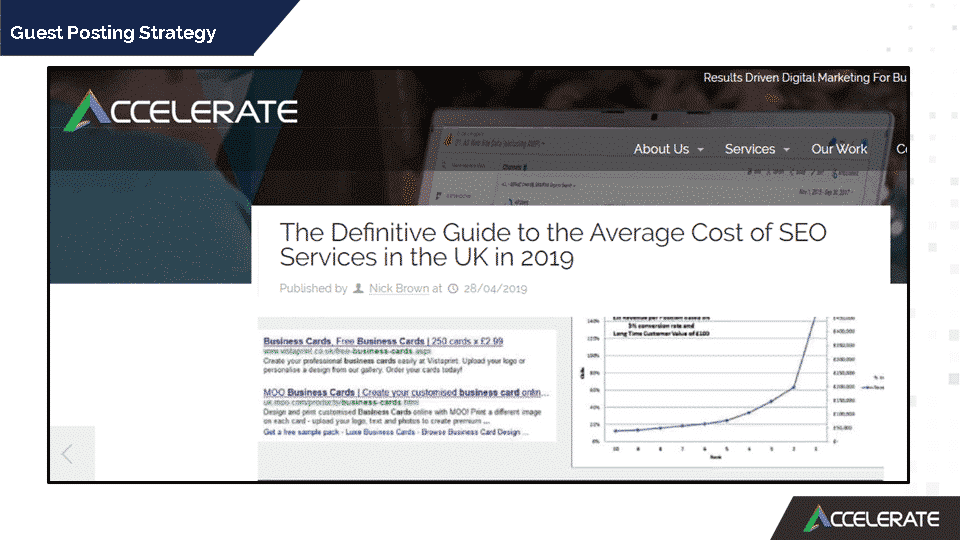
And that from HubSpot links to the article here.
So, having a guest post on a site like HubSpot, it actually helped with our branding. We could use “as featured on HubSpot,” increases our awareness and expertise.

[00:19:22] Referral traffic. They promoted this on their email list, which is quite massive –– also, with their social media. It actually drove a lot of referral traffic to our website.
[00:19:36] High authority do-follow backlinks from very, very high authority website Hubspot. It increased the authority of our website, boosted it by 2 Moz points -– if anyone knows Moz here. And it created business opportunities for funding or partnering. So they wanted to invest in our agency, and they wanted to partner with us, as well, just from this article. It increased the organic traffic to that to a web page on our website for about 20-30%. And now we’re in a position we’re able to refer clients and fellow guest posters to write for HubSpot.

[00:20:16] The next one is a bit of an unusual one. It has a different strategy we took. This is a Google analytics tool. What we’re actually doing at the moment is actually just built it and it just completed a couple of days ago.
A few months ago, we started marketing this tool. We started to roll traffic to –– we created a post, which was all about Google analytics tools. Because, obviously, we’ve just launched this Google analytics health check tool.

The first thing we did, we looked at what keywords are going to be the most relevant. For example, we did some research and we worked out actually that for the Google analytics tools the best keyword to actually rank for would be “Google analytics tools.” It makes sense.
What we did, we thought of a few ideas. This was quite a different idea we had. Phil has basically established a following of marketers interested in Google analytics. This is comprised of industry experts and people who also are interested and involved in Google analytics.

We posted on Phil’s link though he was planning to write a roundup of the best Google analytics tools on the web.

We asked for suggestions and input from his audience on LinkedIn. Needless to say, it got a lot of interactions. So I think we had 254 likes, 130 comments, and nearly 29 thousand views on this one LinkedIn post. Because of the way it was written, also, we hit out key demographics as well. And we got 10 reshares.

We then wrote an article based on people’s suggestions. And we came up with the top 39 Google analytics tools.
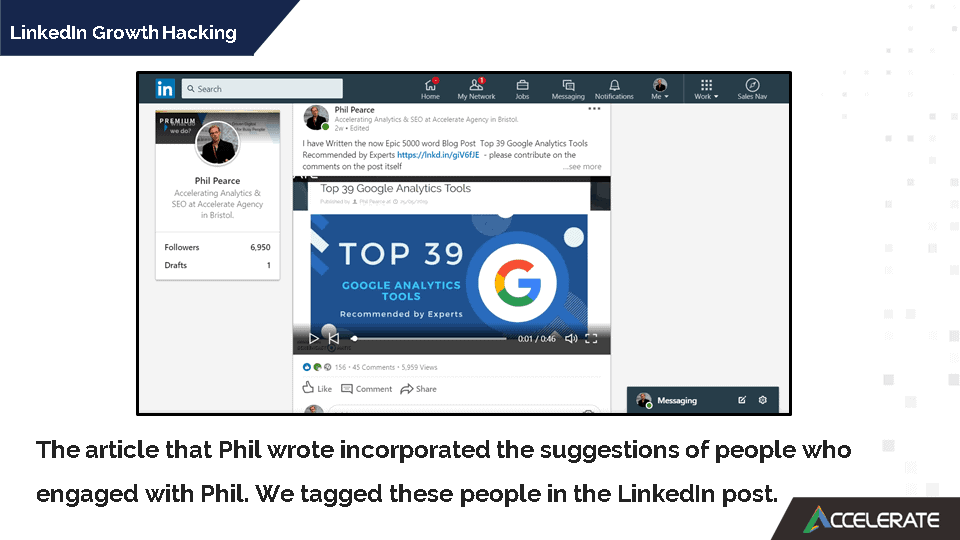
We tagged the people that liked the post in the previous list. The post was promoted in various LinkedIn marketing groups, and it was reshared 24 times.
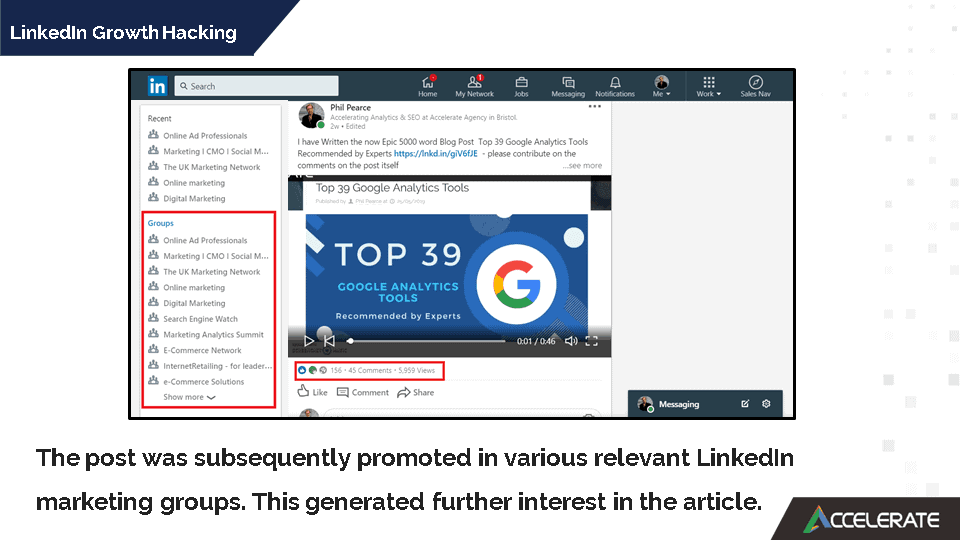
All in all, it generated about 2000 unique visits to our website just from this LinkedIn post.
[00:22:25] As a follow up to this article, we stated that Phil was interested in exploring new guest post opportunities: I love writing about technical SEO and Google analytics, especially DTM. I am looking to do guest post blogging. So if anyone has any opportunities, please let me know.
[00:23:15] This created a certain number of guest post opportunities, including sites like
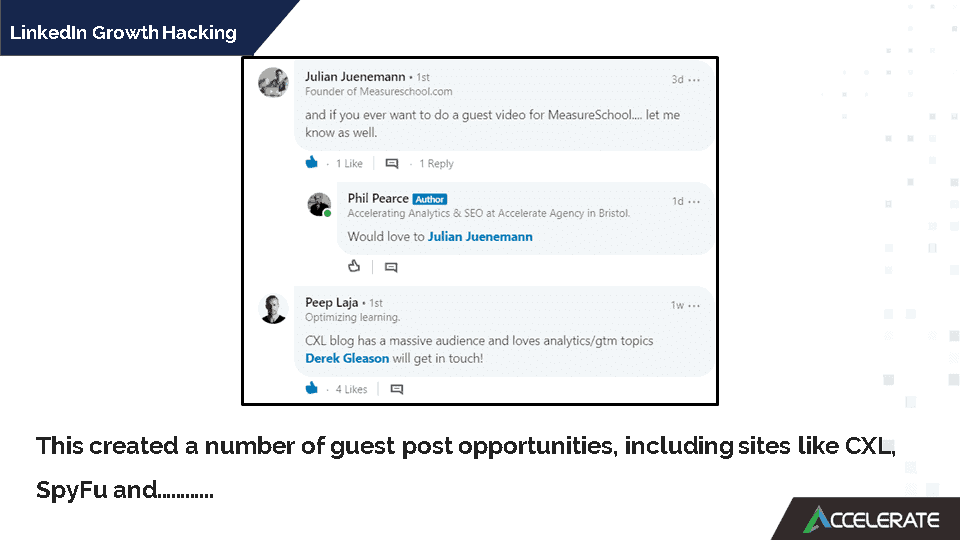
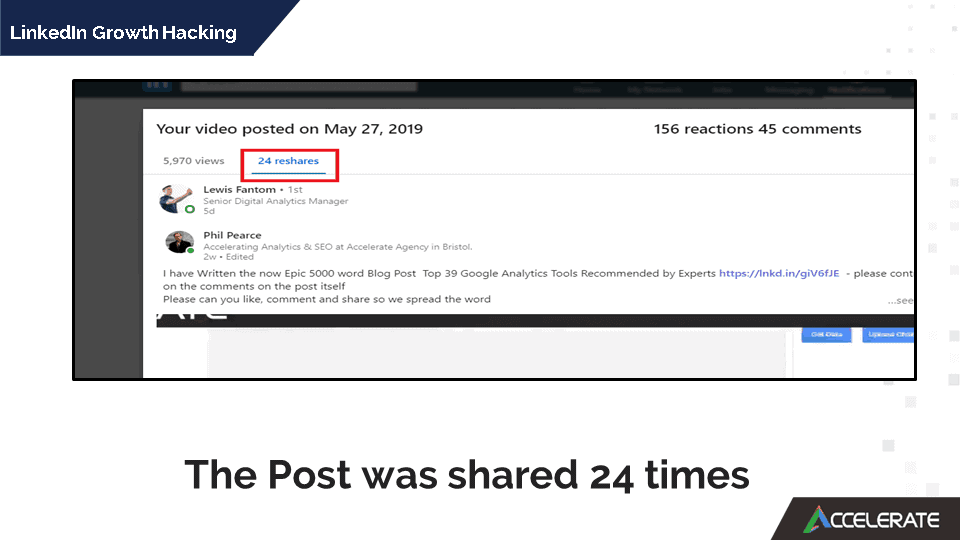
Conversion XL, SpyFu and Mailchimp.

Phil was contacted directly by Mailchimp and they have since written 15 articles on Google search content and Google Analytics, which is due to go live next month –– which is great for branding authority and very powerful backing to accelerate our clients and friends.
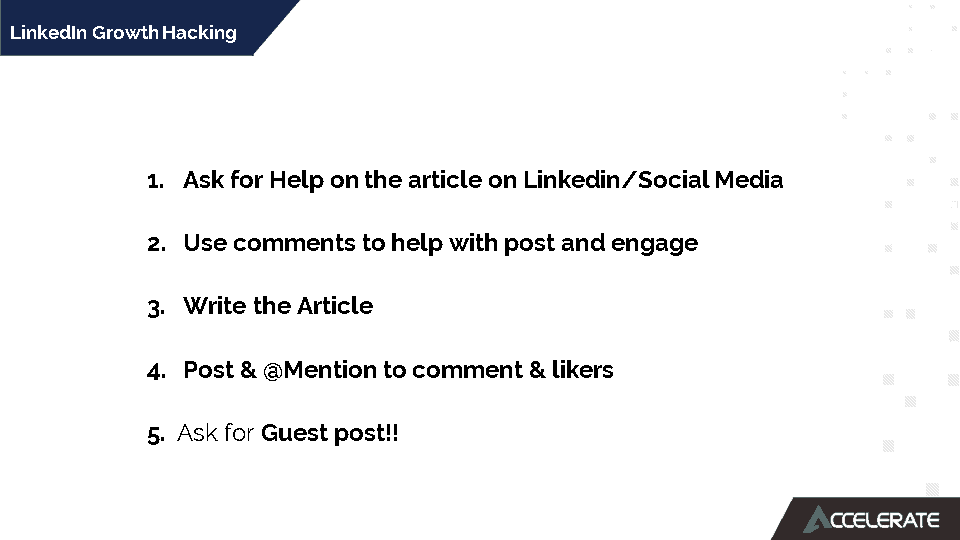
[00:23:47] This is the strategy what we employed on LinkedIn –– to ask for help when writing the article on LinkedIn, get people’s input and advice, use the comments with the actual article, write the article, post and mention the people that inputted on the article. And first of all, ask for something –– ask for guest posts, ask for speaking opportunities, have an ask after you’ve done this.
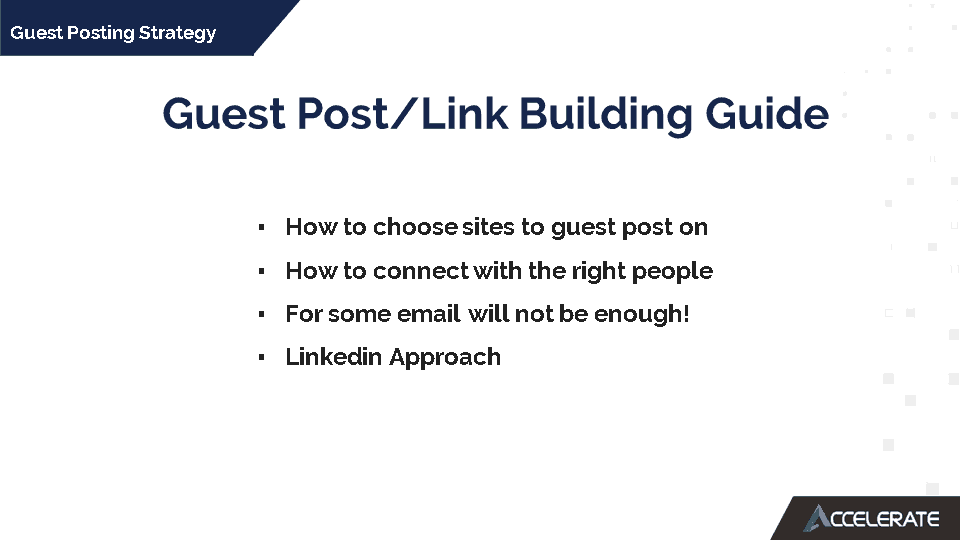
[00:24:22] This is a quick guest post and link building guide: (1) How to choose sites to guest post on; (2) how to connect the write people; to some, emailing won’t be enough. And then, (3) you can take the LinkedIn approach.
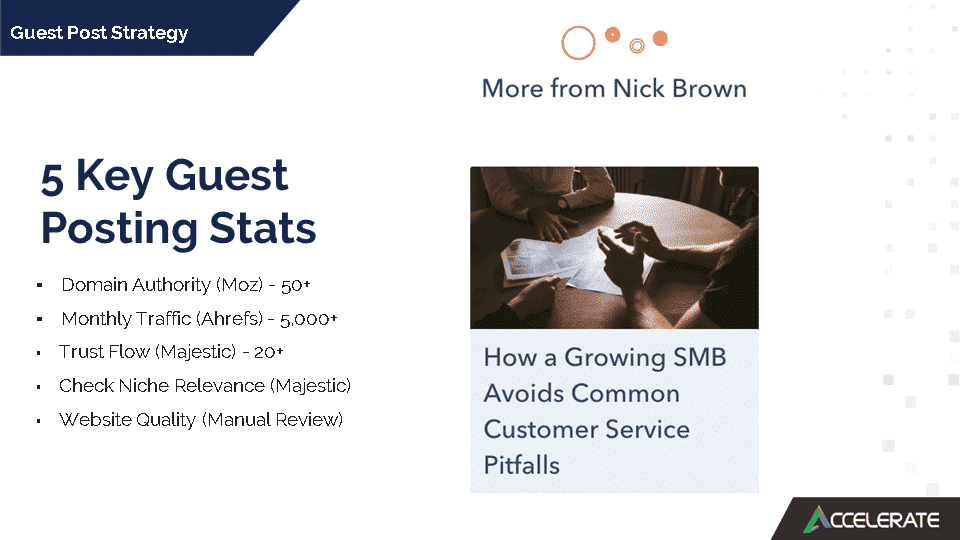
[00:24:35] Five key guest posting stats.
There’s a tool called Moz that most people would know what it is. Domain authority is at least 50. Monthly traffic is at least 5000 in the actual country you’re trying to rank for. Trust flow of at least 20 plus –– this is a majestic ranking, which shows you how trustworthy a domain is. It’s a very good tool, I recommend it. But then check relevancy. Relevancy is really important.
For example, if your website’s about accounting software and you going to link from a vegan site, it’s actually going to get penalized for that link. And obviously, always do a website check –– make sure that the website is of good quality by just manually looking at it.
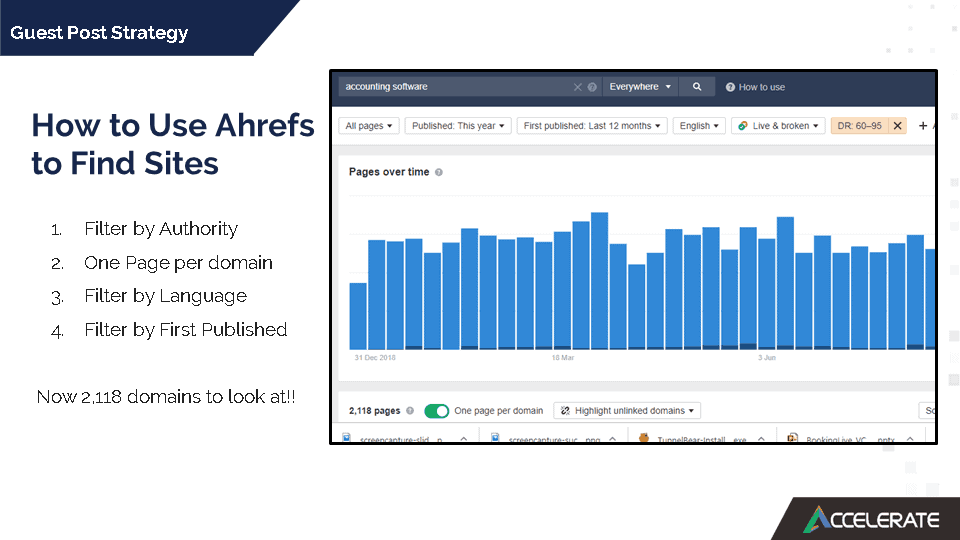
[00:25:35] To find relevant and high authority sites, we use a tool called Ahrefs and we use the content explorer option (feature). We filter by authority, to make sure it’s powerful to me. We then change it to one page per demand, otherwise, it’ll just –– if I got ten pages, it will show you ten pages on here. So filter them down. Filter by language. Make sure it’s English. We’re doing everything in English, and filter by first published –– is it in the last year the article is published. Now, this brought us to a total of –– we’re doing an example here of accounting software –– this brought us to 2118 domains.

Then obviously you want to use a tool called Majestic. Majestic shows relevancy. So for the accounting software, I did some research and looked at what was number one on Google for accounting software. And it was Xero.
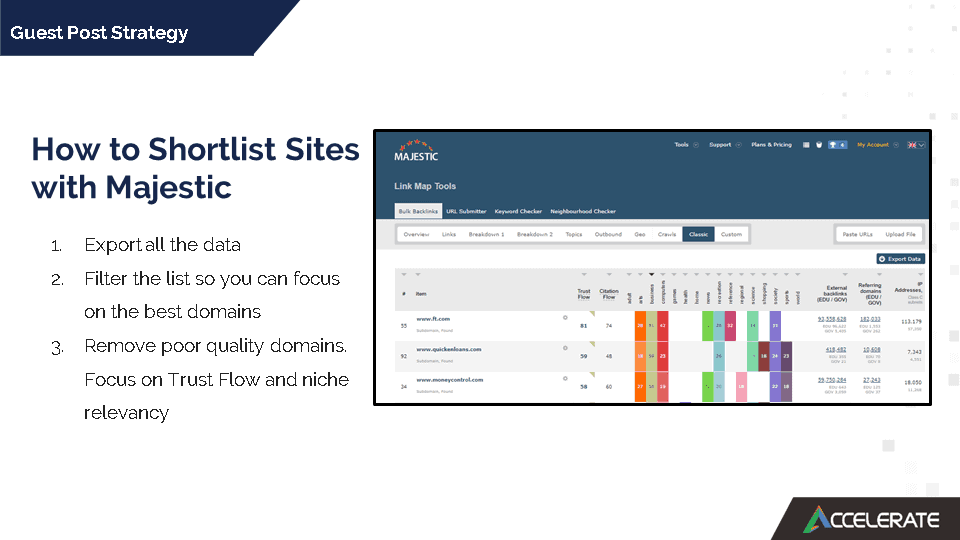
So its –– you want to rank that keyword. You have to look at what niches there are. You should be down to about 400-700 domains now. And so you’ve already filtered down from 2000 to 400-700.
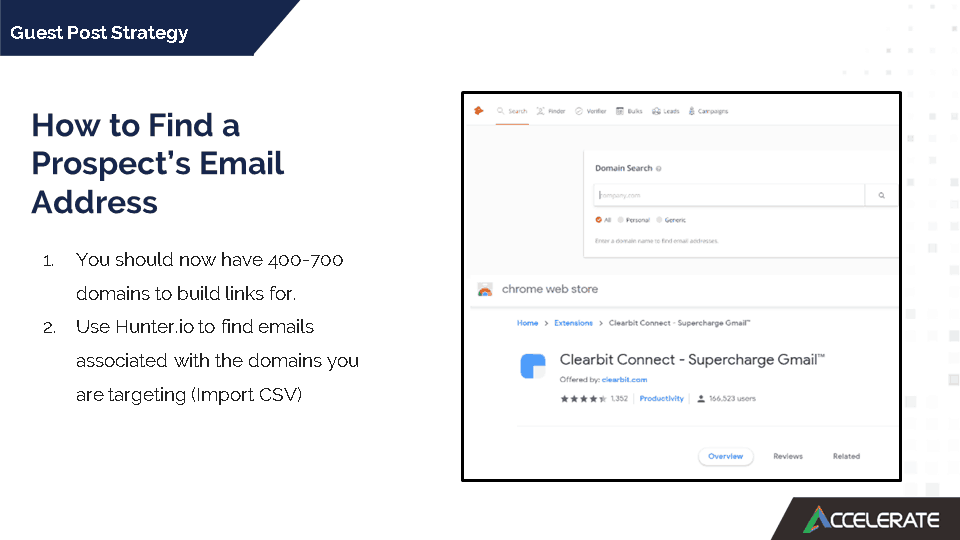
[00:25:49] Now, you can have to find the email addresses of the people in the company you need to connect with. You can use tools like Hunter and Clearbit Connect.
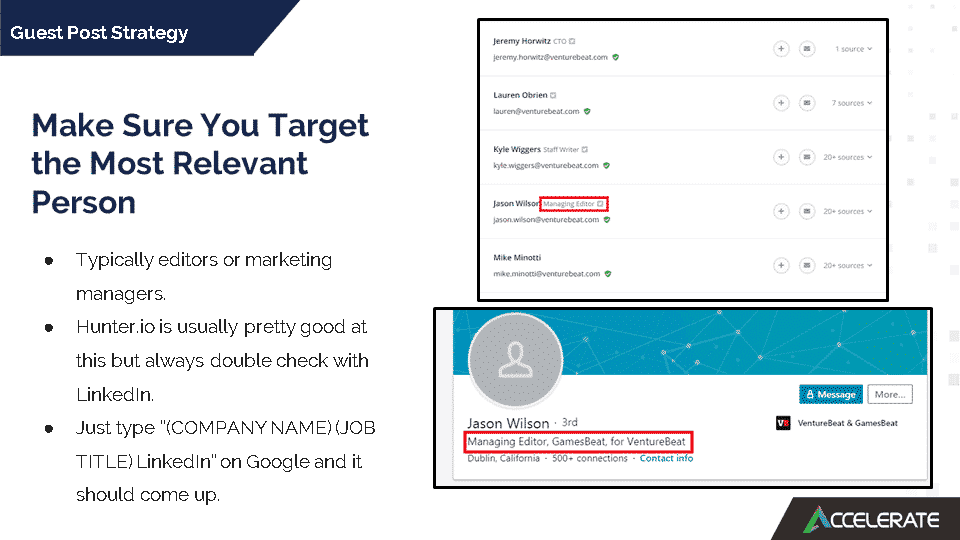
And you need to make sure you actually emailed the most relevant person in the company. Hunter is very useful for this. For example, using (searching for) VentureBeat here and it brought the name of Jason Wilson, who is the managing editor. Sometimes it’s not enough so you want to search by company name on Google, job title, and then LinkedIn –– to find that actual person.

Then it’s time to begin outreaching to these people. Use outreach software. It would just save you a lot of time than making it manually. Manually it will take a very long time to manually email 400 domains.
[00:27:42] Create the first template –– so the first email to go out. I will show you an example later. I’ll create a follow-up email if that person doesn’t get back to you within a week. If no response, email the next person in that company. And reject people that ask for money.
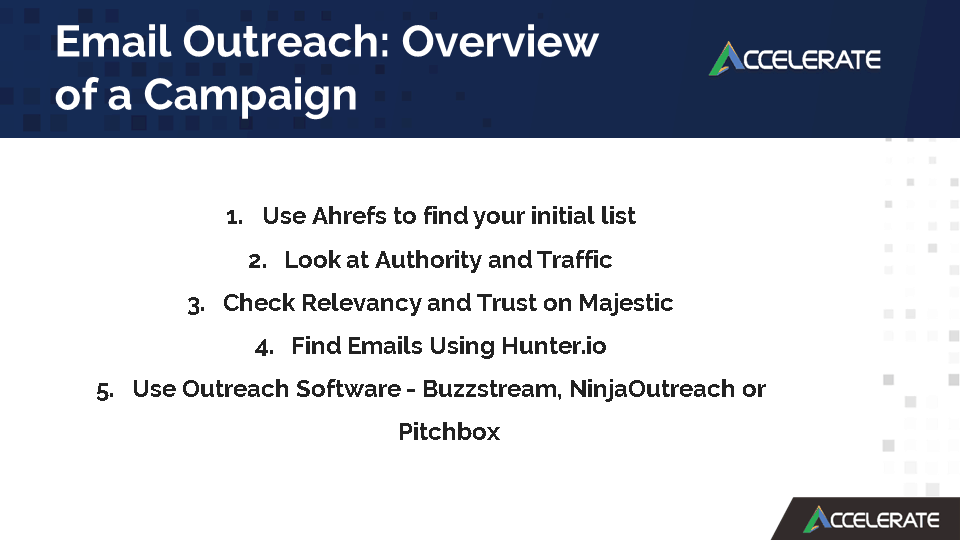
[00:28:06] So here’s a roundup of all I’ve been going through (1) Use Ahrefs to find your initial list; (2) Look at authority and traffic; (3) Check relevancy and trust on majestic; (4) Find emails using Hunter; (5) Use outreach software –– examples of the ones we recommend are BuzzStream, NinjaOutreach or –– kind of the Rolls Royce, which is Pitchbox. You’ll all see it’s got a Rolls Royce price as well.
[00:28:30] Okay, giving an example here of a common outreach email. This one has been very successful. We generated about 30-40% return rate on this one.

[reads slide] Hi, my name is –– from “your website” –– what we’re about. While searching for –– I was grateful to discover your article. Quite glad I’ve found it as I’ve bookmarked it as a future resource to our blog. I’m reaching out to see if there is an opportunity to contribute to your website. I’m currently working on an article and I believe it would be a tremendous fit for your audience.
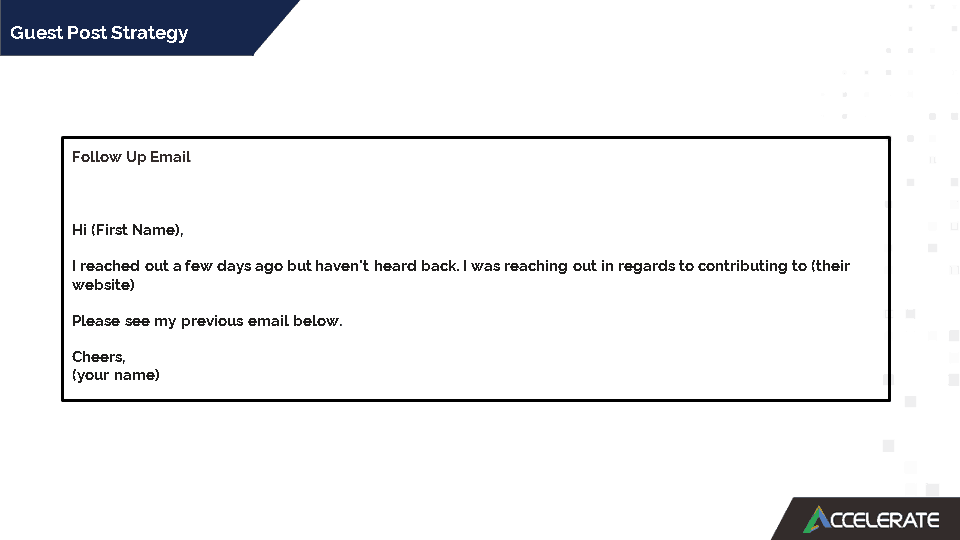
And it carries on. And then, if they don’t reply within the week you do a follow-up email.
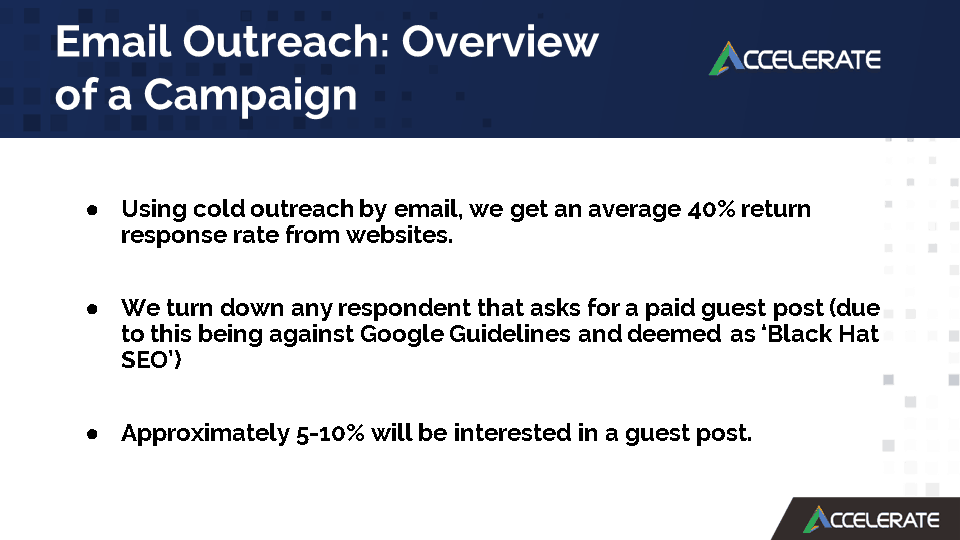
[00:28:18] Overview of this campaign.
Use cold outreach by email. We get an average of 40% response rate. We turn down any respondent that asked for a paid guest post due to this being against Google guidelines and deemed as black hats. Approximately 5-10% will be interested in working with you.
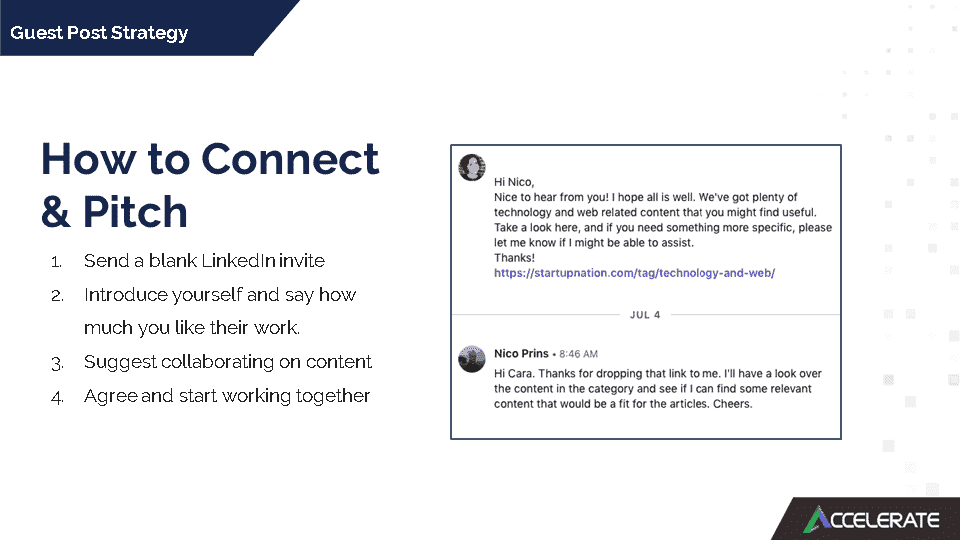
[00:29:41] There’ll be certain target sites that you want to work with, you want to get an opportunity with. Sometimes email just won’t be enough. And it’s best to connect with them on LinkedIn. So you can do, obviously, a quick company search and look for the editor or writers within that company that you want to work with. Send a blank LinkedIn invite, introduce yourself, and say how much you like their work. Suggest collaborating on content and agree and start working together.
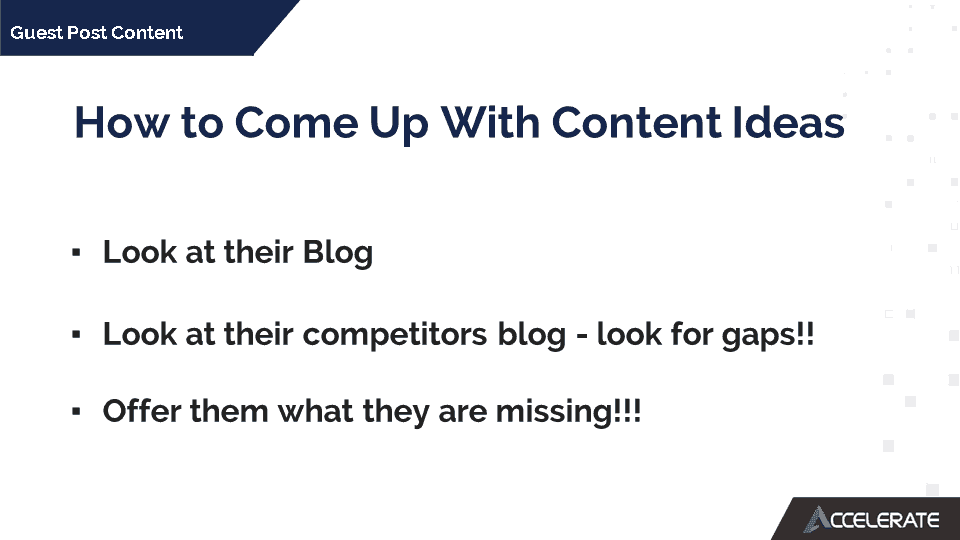
And finally, you will always be going to work out ideas. You’ve got to pitch some ideas if you want to write content for them. The best way to do this is to look at their blog. Look at their competitor’s blog. Look for gaps –– that’s key. Look for gaps in their content and offer them what they’re missing.
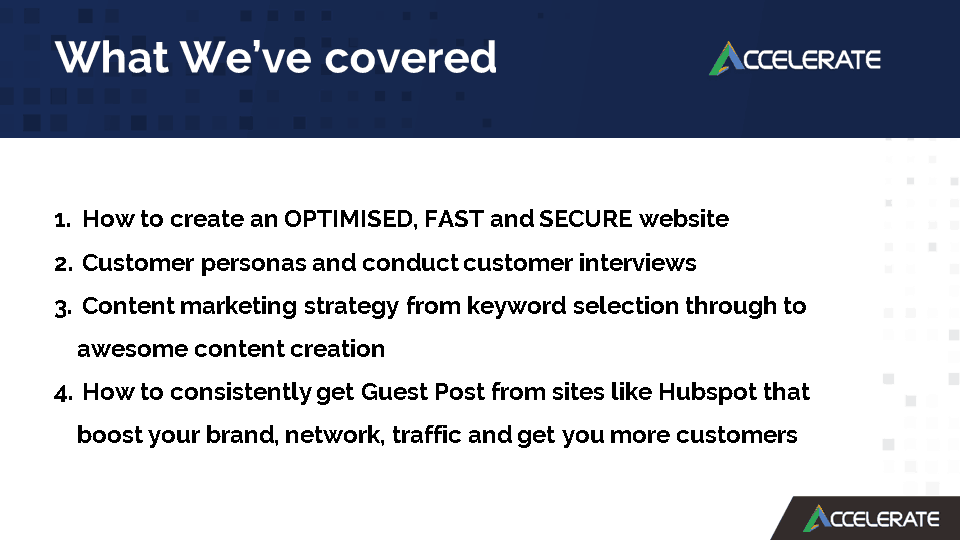
[00:30:39] So what we’ve covered in this presentation so far: (1) How to create an optimized, fast and secure website; (2) Customer personas and conduct customer interviews; (3) Content marketing strategy from keywords selection to content creation; (4) How to consistently get guest posts from sites like HubSpot; (5) and, boost your brand network traffic and get more customers.
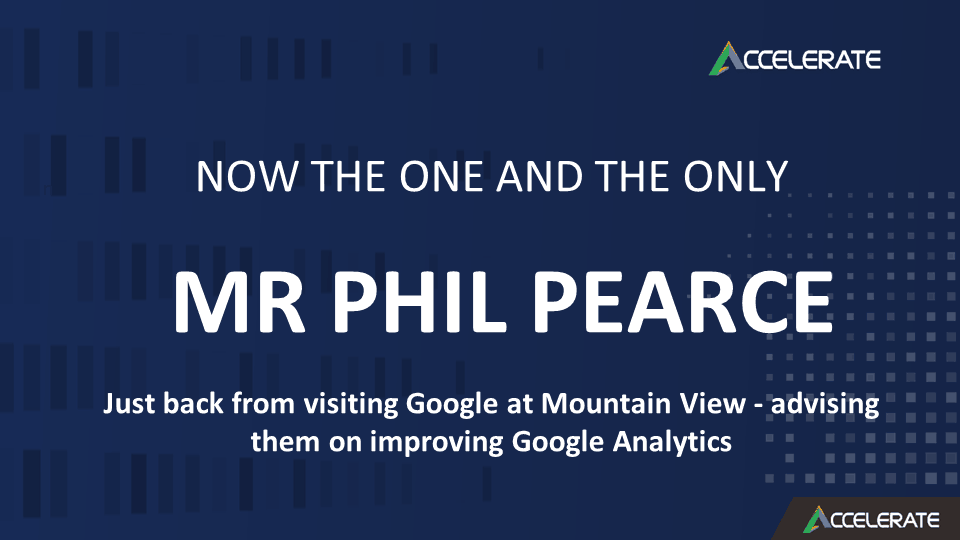
[00:31:04] And now, it’s time for the one and only Mr Phil Pearce, just back from visiting Google at Mountain View, advising him on improving Google analytics.
PHIL PEARCE’S PRESENTATION

[00:31:04] On this one, we’ll cover a slightly different angle on this. You’ll see what’s going to happen here next. Just quickly about myself –– so I’ve been doing this stuff –– into analytics and SEO for 20 years or so –– so a lot of experience.
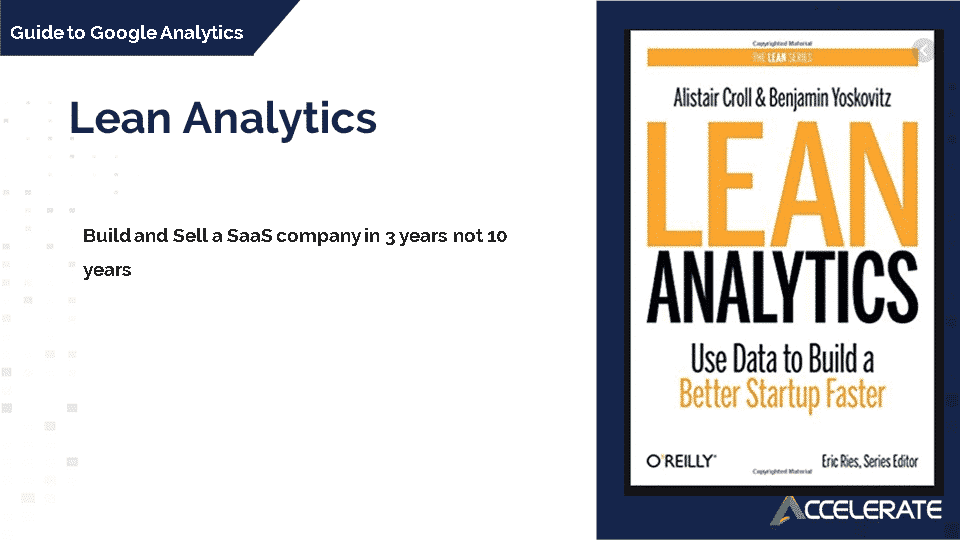
One thing which I thought we haven’t really covered. It’s a little bit more on the strategic level. And I just wanted to mention something, which people within the room may or may not be aware of –– within the SaaS industry. There is this series called lean startup –– how many of you here are aware of that? Most of you. How many of you’ve heard of the lean analytics within the lean startup series? Only one or two. So this is good.
The people within this room, if you are in SaaS –– you should know about this because there’s really good stuff in it. The premise of this book was actually how do you build your startup and sell it within three years, not ten years. And it was the work from Year One Labs in Toronto and it was compressing all that knowledge from a bunch of companies in America –– to find the one single metric that mattered and allowed them to build and grow a lot faster and quicker.
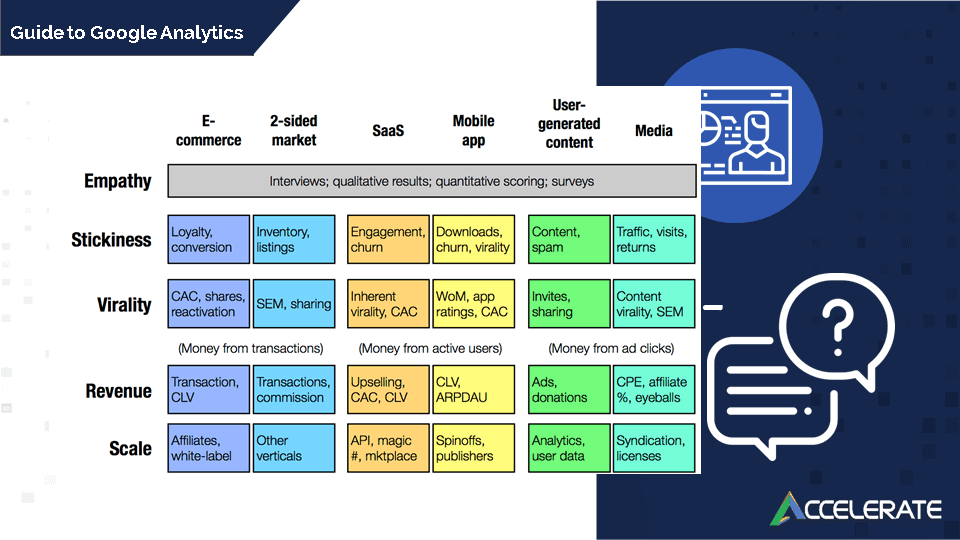
I’ve highlighted the grid that they use within Lean analytics. And there are two specific kinds of areas I just want to highlight here. You see, it says SaaS in the middle here and also the mobile app.
The premise of this is that based off of the size of the company that you’re at –– for instance, how many people work in your company. That would affect which metric you should pick in terms of what you should really be focusing on to supercharge your business, get more customers, sell more stuff, and grow quicker, faster, better. So the way this works is once you’ve nailed that one single metric, you then move to the next stage. So you would start doing interviews and surveys and picking up the phone to say, you know, is this business a good idea? Does it –– are people going to buy it if I create this idea? And if there’s a kind of a bit of empathy and traction, then you’d move to the next stage, which would be –– are people actually going to get their wallet out and buy it.
The reason why this is important is if you focus on that one single metric it allows you to –– you really, kind of, focus minds and align. And that’s also extremely important when you’re dealing with marketing where you want to get more customers quicker, faster and also outperform or outmanoeuvre your competition.
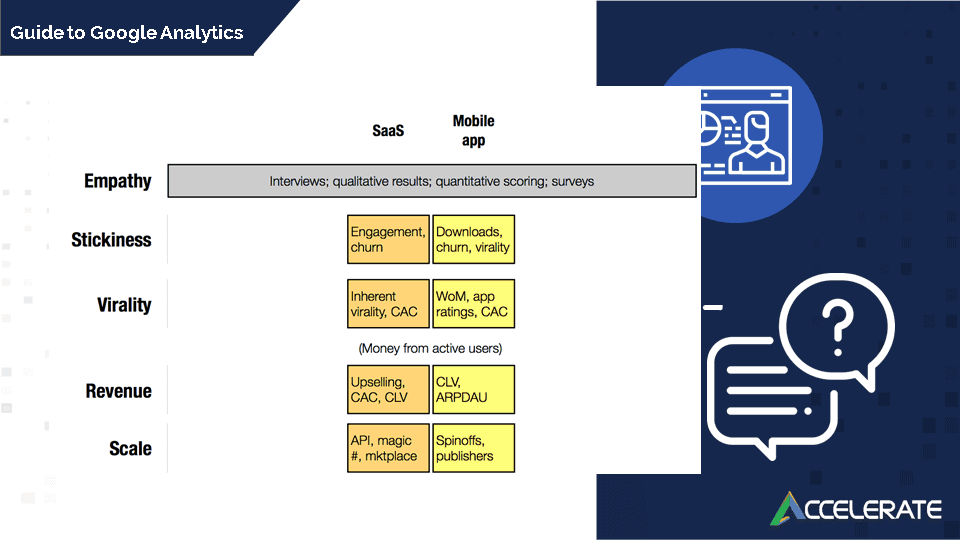
And once you’ve also done that and you’ve hit a certain number of sales or target, you then move to the next stage for the next metric for your business at that specific time, with the end goal being to sell or IPO at the bottom. So this is a very useful framework for literally focusing minds and working out what you should be doing, and this is based on shared learnings from other Saas-based companies or mobile apps. There’s a whole set of information that explains this in more detail on Amazon –– on Alistair Croll’s book.
 But don’t buy the book. I’ll save you £30 on it. Instead, search on YouTube for the video for lean analytics. And there’s an excellent video –– it is one-hour long –– but if you compress one book into an hour that’s a really good thing. There’s a huge amount of really useful information in that video. And if you’re not aware of it already, definitely go for that and watch it.
But don’t buy the book. I’ll save you £30 on it. Instead, search on YouTube for the video for lean analytics. And there’s an excellent video –– it is one-hour long –– but if you compress one book into an hour that’s a really good thing. There’s a huge amount of really useful information in that video. And if you’re not aware of it already, definitely go for that and watch it.
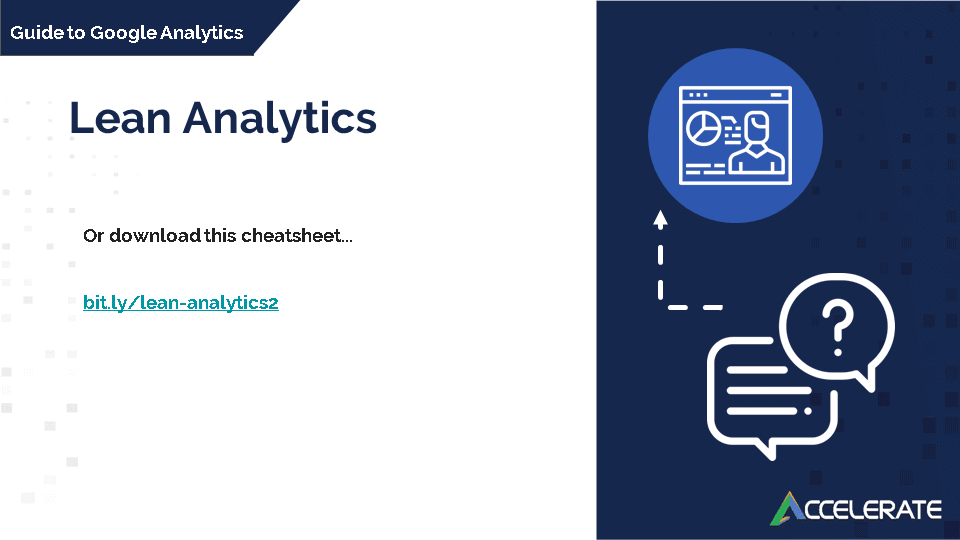
Additionally to that, I did a tribute to Alistair Croll’s work. I looked at what he’d done and applied my own experience to that. I didn’t know that the method he was using was called lean analytics. But when I looked at his work, it’s like, ah, there’s an alignment here.
I’ll just tell you one story about that. I worked for a startup called Compare and Save, who are based near London. They actually were kind of a little bit like a two-sided marketplace –– as in, here are comparison sites that sold credit cards as a table –– a bit like a money supermarket. They had a list of which credit cards people should buy, or click to –– and these are affiliate links. And they got paid, let’s say, up to £50 per sale. And they also purchase traffic on Google Adwords. So on cost-per-click, it was a perfect model in the sense that the more traffic that they bought, and the more volume they sent to the banks, the more they earned for their, kind of, costs to acquire. Originally, when they first started, they were only earning, let’s say, £10 per new credit card signup. But by the end, they were up to, like, £50 per sign up. So the amount they were making is increasing per lead, and the cost that they were paying to acquire those new customers from Google Adwords was going down, as well -– because Google Adwords was rewarding them for the volume they were sending.
Google Adwords –– the way that the ad words algorithm works is that it’s largely based off of a thing called click-through rate, which is the number of impressions that people see your ads versus the number of real clicks on your ads. So it’s called CTR. And Google works a bit like Amazon or Walmart, where it’s all about volume. They want you to search and then click, and the more clicks, they basically reward you by making the cost you pay less than everyone else. So this perfect model where CPCs were going down, and then the cost they’re making was going up so –– the perfect metric for them at that stage was actually CTR –– because that perfectly lined that business.
That business also sold for £30 million –- about five years ago. It definitely worked for them. So there’s a lot of truth to these metrics.
[00:37:30] I’m going to just shift a little bit more into some tactical tips. Lean analytics was about trying to use data to outmanoeuvre or outperform by being a bit clever or strategic about stuff. You can also use some of those same methodologies for growth hacking or growth marketing using some free tools. We’ll mention a couple of examples using Google Analytics and Hotjar. And I’ll go through these in a second.
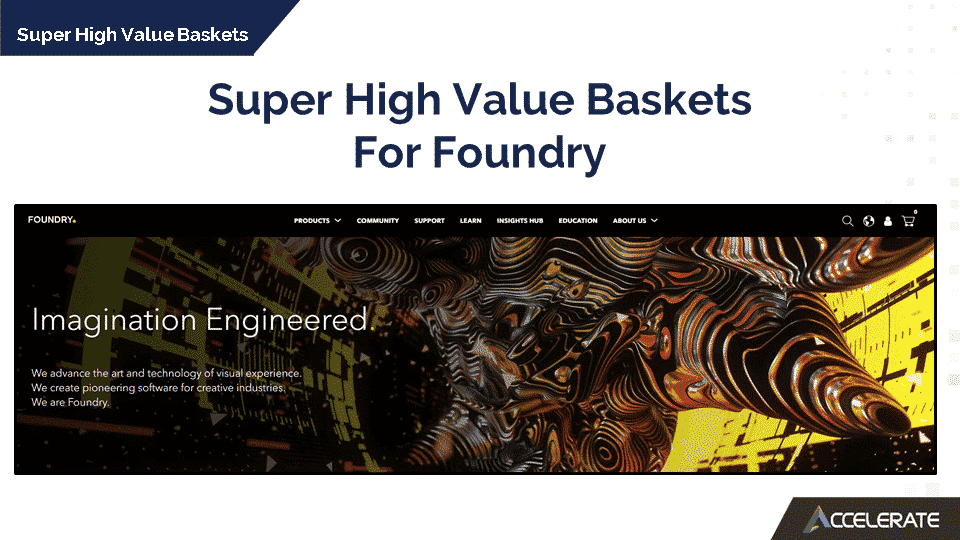
[00:38:03] One I’m going to mention –– so this is actually a software site. They are using a free tool called Hotjar. Hotjar is something that records the mouse movements going through the website. It is free up to a certain point, and it’s a very, very good for analysis of user journeys and forms going through a website. It is especially useful for detecting those conversion issues with people filling in forms and they’re getting stuck and stuff. What’s even more useful though, you’ve got a relatively expensive, kind of, SaaS product.

This one here –– there are three prices. One being the most expensive –– which is about £8000, which is quite high for a product, this one be it software rather than SaaS. But it’s very similar.
[00:38:48] The cool thing about Hotjar is knowing that you’ve got these really high-value users. But the problem is they may not necessarily buy there. And then they might abandon. So it would be really –– we’re still waiting for data from this –– but I’m going to throw this idea out there as it’s something you can take away and use today –– which is to break out your basket levels into sizes: (1) Here are your really high value enterprise-level customers; (2) you’re medium value baskets; (3) and then your low value baskets.
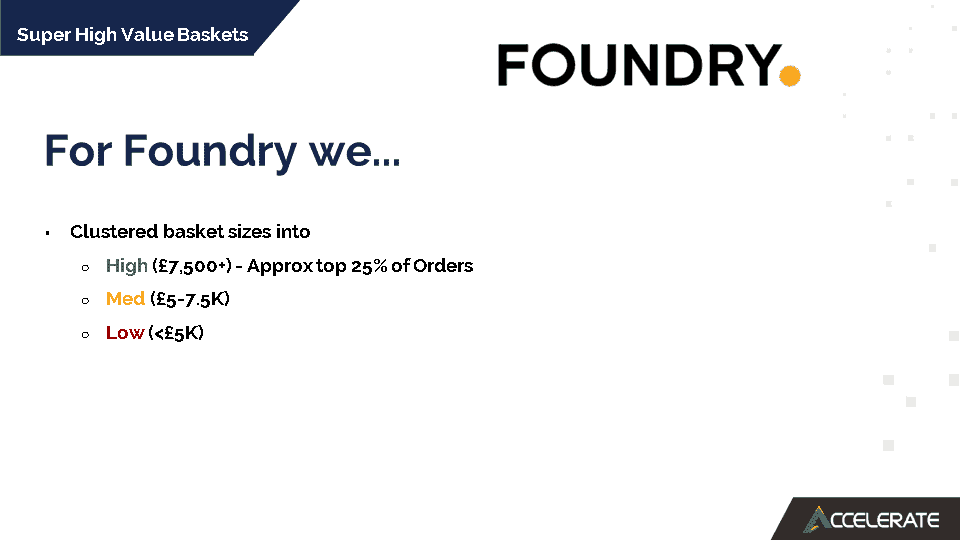
By breaking out those customer types you can then replay those sessions from Hotjar to say –– time everyone in the higher value basket up here that was about to spend £8000.
But they got stuck as they were going through the cart. They’re like something either confused them or distracted them or, you know, it didn’t work. Like you’ve just got £8000 on the table, but they didn’t get to the final check out –– they didn’t get past the line. So those ones you really, really want to replay those sessions. You want to know what went wrong.
[00:39:51] So this method has allowed them to do that. This does require using the tag feature within Hotjar, which is where you add a little label to a user as they’re going through it. And you do need the business version of Hotjar to be able to use that. But an extremely useful marketing hack for SaaS and lead-gen-based businesses.
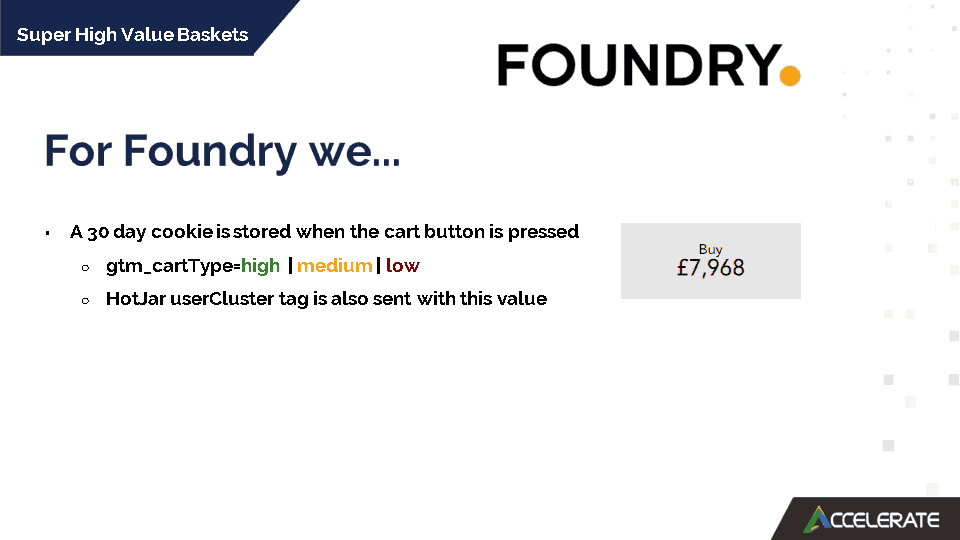
[00:40:10] The other cool thing about this was the users that had already purchased, those got kind of taken out of the bucket. Because you don’t need to replay them, they’ve already done what you want them to do. It also allowed you to persona those users and so you know that they’re in enterprise based on the size of the basket –– and also push that data into Google analytics of the customer mentioned for further analysis or remarketing, etcetera. So a cool little tip or hack you can take away.
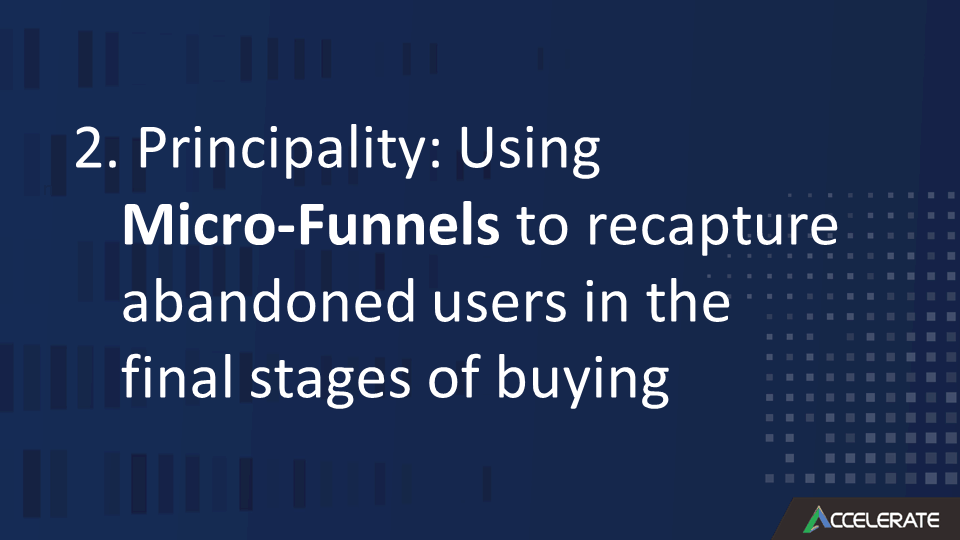
[00:40:40] Now this one is for lead-gen, which even for SaaS there’s going to be a lot of forms on websites.
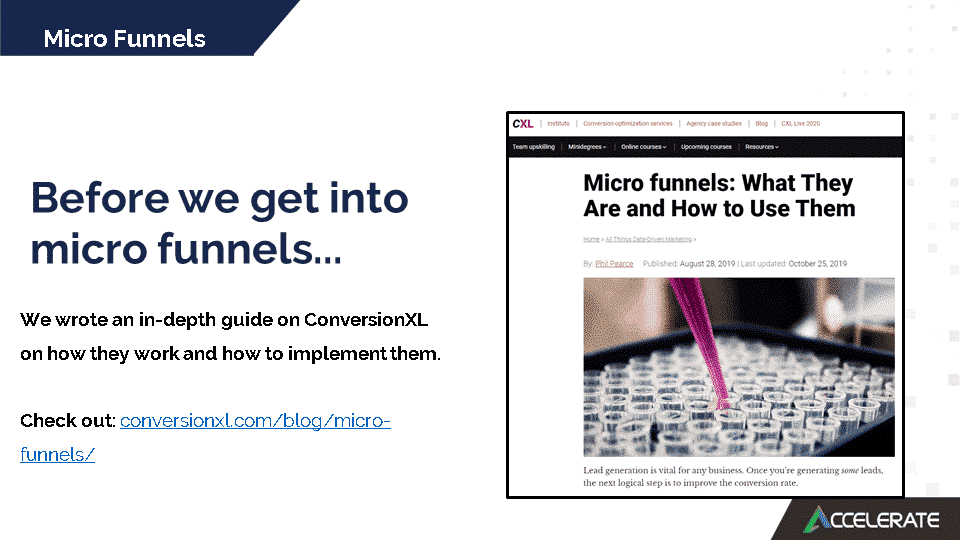
So this is actually –– the details of this are online –– so this is a thing called micro funnels. Within Google Analytics, you can actually set Google Analytics to send a page to you whenever someone traverses between forms on a site.
Let’s say, first name, surname, last name, etc., or email address –– Google Analytics out the box will show you they’ve landed on that page–– let’s say, demo signup page –– but it may not necessarily tell you which field they’ve left or got stuck on. So this method allows you to see the individual field –– or the last one they interacted with –– and also if they keep going back to that same field, so it highlights and if there’s a problem with this specific field or question on a website.
The great thing about this method is –– in the same way Google Analytics is free –– if you enable this, you’ll have a free way of seeing that information forever. Which is pretty cool.
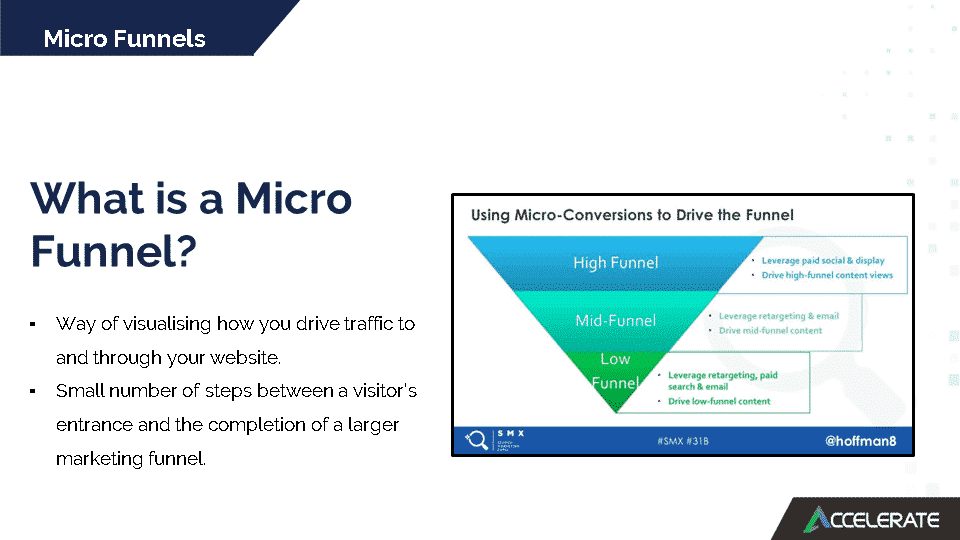
And it’s really relatively easy to set up, as long as you got something like Google Tag Manager on the website.
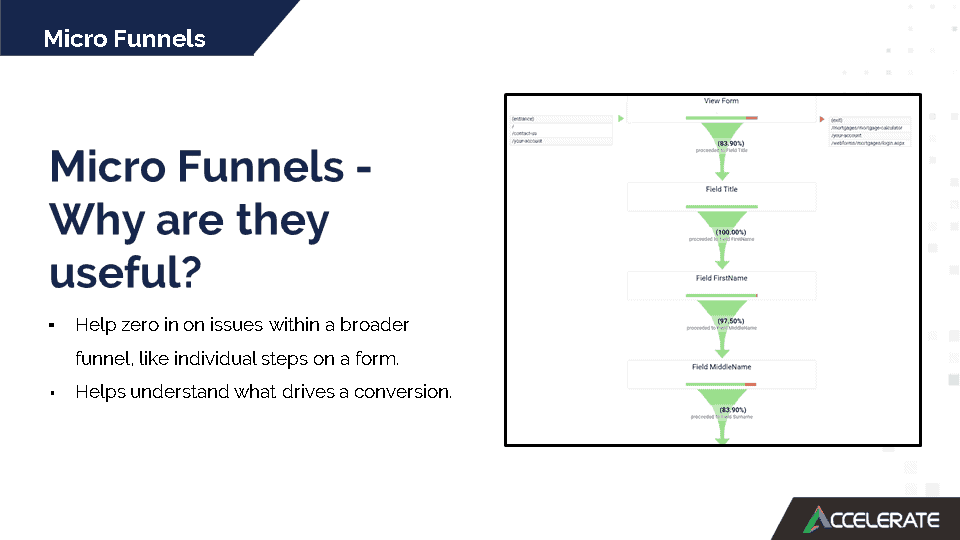
It’s also helpful to have the names of form fields also exposed on that. So this also tells you a more granular level or breakdown of your funnel; so, instead of you, kind of, macro or individual –– they viewed the form and they went to the Thank You page –– it breaks it out into these mini-steps or micro funnel steps. And you can see that in Google Analytics –– you can see it in the form, kind of, flow report. You then also be able to see that leakage and also the rate of leakage, so people keep refreshing a particular field, that will –– you will see them.
[00:42:32] This was very good for a site where they had a problem with a postage kind-of look-up. Because people were selecting and entering a postcode, clicking search –– and either it was not finding it or forcing them to manually enter, enter your address on its own. And also one of these websites was actually asking for a National Insurance number, which also left people, like, scratching their heads –– what is that? Why do I need that? It highlighted some optional fields which were causing confusion, preventing users from purchasing or filling out forms, and thus, prevented them from making money. So it’s extremely useful in the ways of finding problems, which would prevent you from scaling.
[00:43:10] Bear in mind, we are talking about a leaky bucket problem here. As more marketing you push at this –– if you’ve got holes in the bucket –– you’re just not going to have an efficient funnel. So, it’s really important to nail these issues in order to maximize your efficiency and effectiveness from that marketing spend.
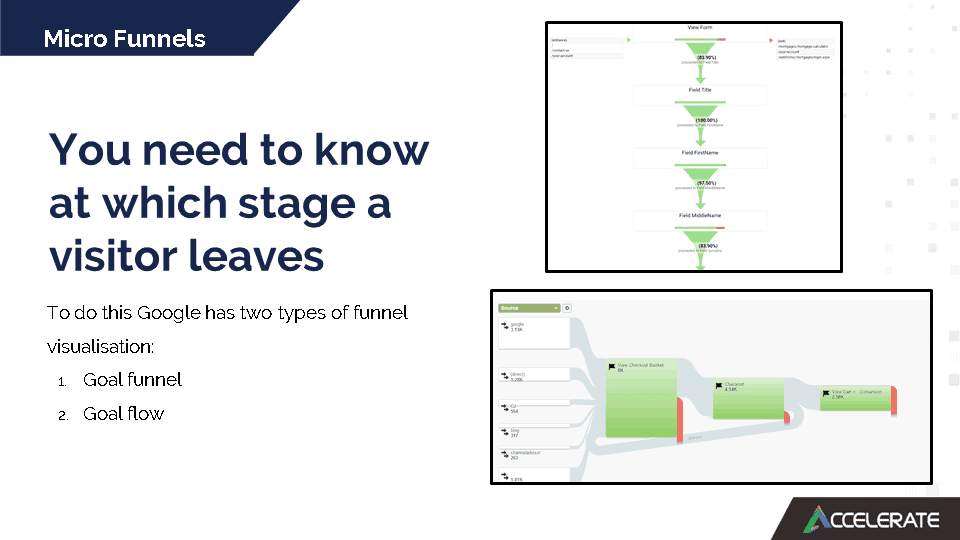
[00:43:10] Here’s a breakdown of this micro funnel, where you can see some of these fields and how it’s going to set up. And you can also see the flow back and forth in Google Analytics with those fields.
[00:43:46] I’m going to give another little takeaway. Now this one is more of a thing you can do at a computer but wouldn’t it be cool if you could walk away today with 23 dashboards for Google Analytics for a Saas-based business? You can –– here’s the link.
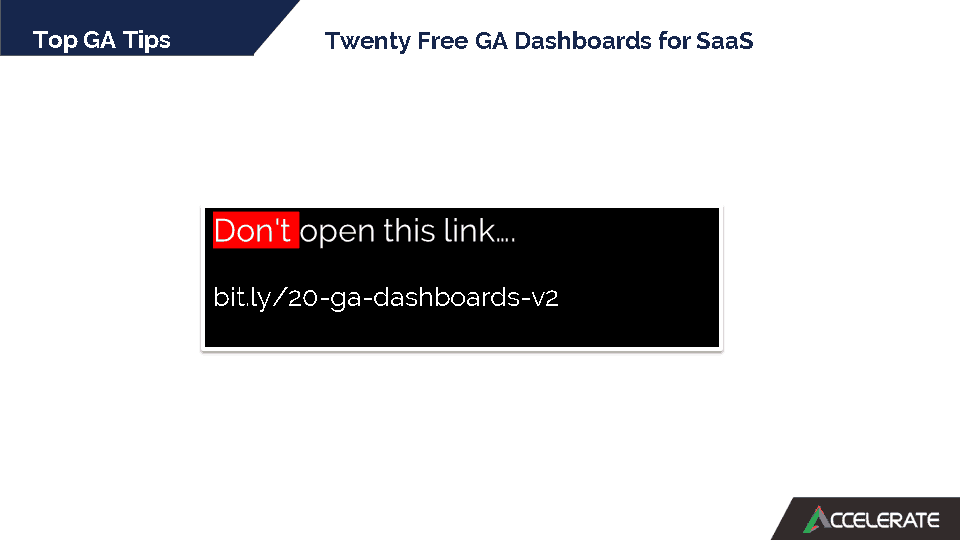
But don’t open that link. It’s not going to work. The reason it’s not going to work is that there’s a second thing you’ve got to do –– and Billman’s taking a picture.
Within Google Analytics, you can bulk-import dashboards. You literally enter a link –– it’ll pop up with 20 dashboards and say –– add this to this profile and –– BANG –– you’ll find them straight away in there. However, in order for it to work properly, you have to tell Google Analytics which is your main goal.

Is it goal No. 1 or is it goal No. 10 or goal No. 20? Whatever your Thank You page goal or form submit goal, you have to basically configure this screen here to say this is my primary goal. And that the link will work. So you do this step first, which is to have a calculated goal, then you can bang out 20 dashboards for SaaS-based-businesses into Google Analytics. That’s a freebie –– they’ll work once you’ve done it, it’s forever in there.

[00:45:03] Here are some of the ones you’d see in there. There are some real-time ones, as well as some kind of marketing ones, SEO, PPC, etc.
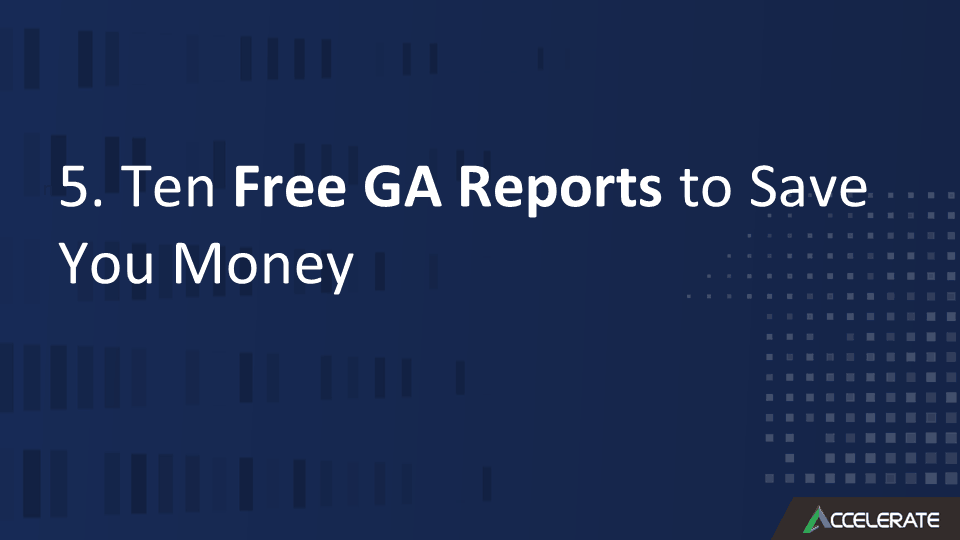
[00:45:09] I’m also going to mention this other tip, which is in Google Analytics. If someone said to you –– where should I look if I want to either save money or make more money. If someone comes to you with that question, there’s about ten places or ten reports that you can look at, which would tell you or give you indications as to things that will help you with those two ends and/or automating of those two things.

[00:45:43] Here’s my common top 10 list. Now, this would be the best and worst landing pages, using a feature called weight advance rate. It estimates pages by revenue contribution; internal Site Search; broken pages; channels that are not performing or over-performing; Adwords data which has got a good return on ad spend or inverse, and then going up a level AdWords campaign. And also Google One, which is relatively new –– which is conversion probability. Which is, let’s say, your SaaS site has a 10% rate of landing and submitting a form. If you just look at that 10% you’d be missing 90% that have expressed an interest in filling out the form but not necessarily filled it in. So conversion probability looks at a broader range and says –– okay, these people –– they got to the step before the form. They started interacting, watched lots of videos, got really good engagement, low bounce rate, pretty close to converting –– there’s a probability of actually converting but it is not an actual conversion.
This is really, really helpful for highlighting good quality traffic, it’s just that it didn’t convert there and then. You can use that to remarket and recapture them or find out why they didn’t get through the last hurdle. Also, intelligent alerts to see if there’s a straight line, what’s changed and why it’s changed. That’s a bit like, kind of, finding human gems or if you don’t know where to look, it would also tell you where to look.
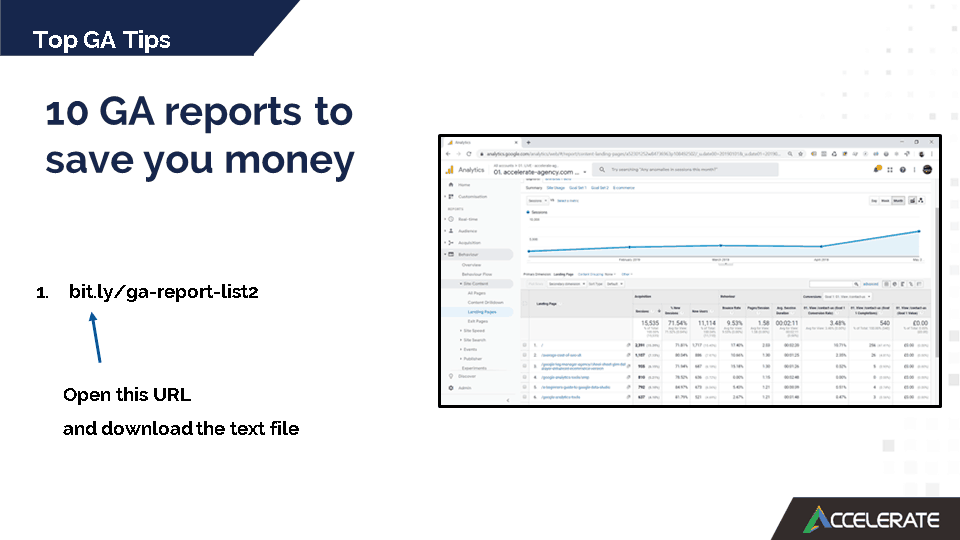
[00:47:13] So with these 10 reports, you can actually jump to all these 10 really, really quickly. I’ll tell you a little tip or hack to do it –– this is a marketing hack got SaaS. You get a copy of these slides afterwards. You can take a picture of it if you want. It says “bit.ly/GA-report-list2” and that will take you to a text file on Dropbox, which has 10 links to each of those 10 reports.
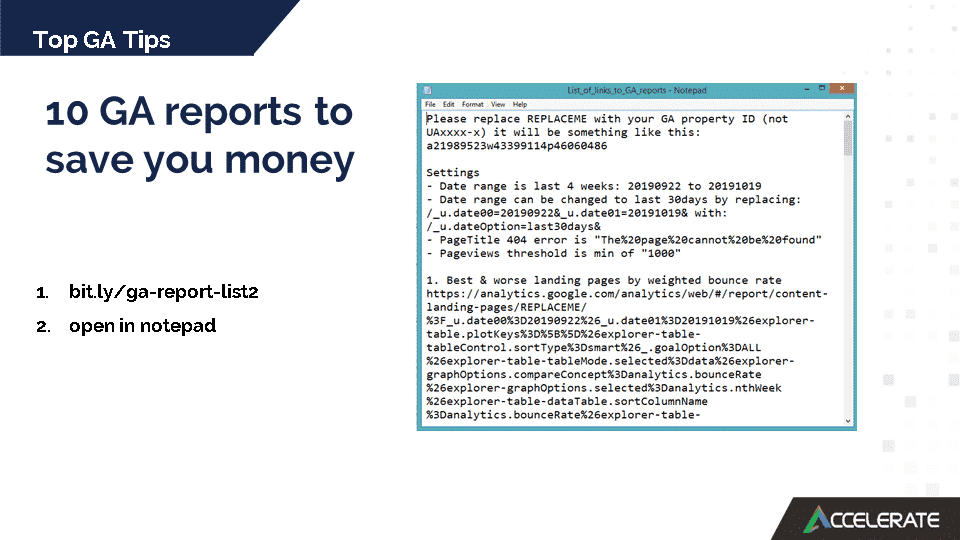
There is one extra thing you need to do to get it to work. It’ll ask you to replace the word “replace” with your Google Analytics account ID.
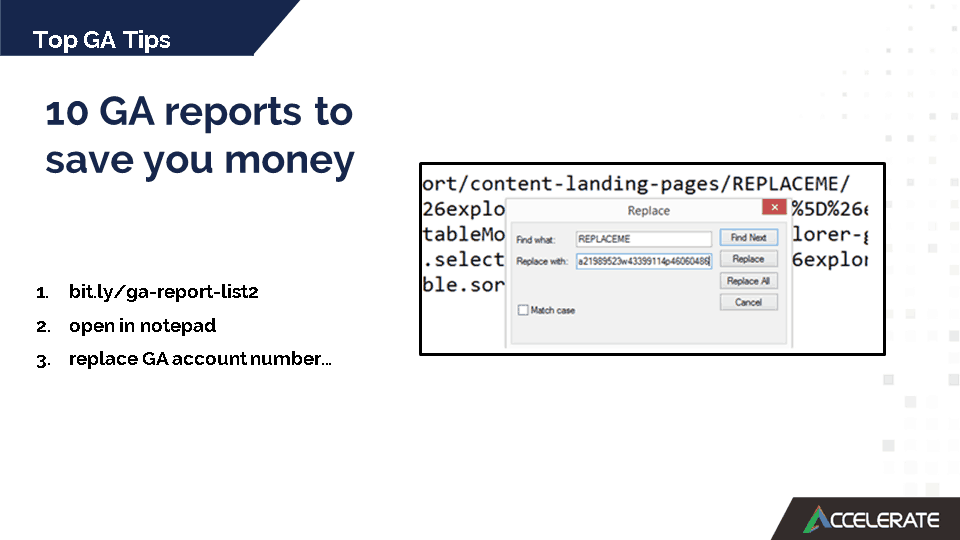
Now, I know what you’re thinking, your Google Analytics account ID –– that’s the “UA-” number you see on the website –– it’s not that one. It’s actually the number you see at the top of the reports when you’ve got your browser open, and it’s like 30 characters or so. If you enter that in this text file, you’ll then have 10 links or 10 reports. So tomorrow or Monday, when your boss says to you –– we need an insight report, which is going to tell us where do we need to look to find out how we can make more money or save money on marketing spend ––– here are 10 places to look, which will tell you about it. So there’s hopefully some good stuff you’ll find within that.

And this is the fifth one I’ve put in here, which is about GTM. Google Tech Manager is a tool for tracking websites but you can template it. It’s a bit like a Lego. If you say our website is on WordPress, Drupal or Magento, and we’ve got Brightcove or Youtube or whatever kind of video software we’re using –– and we’ve got these other aspects. You can basically say –– okay, here’s my tech stack –– and then as solutions reach those bits of a tech stack –– so the great thing about it is you can then go bang, build a tracking solution with all of those elements, you’ll then have a much more enriched data collection –– it’s a piece for your website.
[00:49:20] A very good example of that –– there’s a site called GTM bot –– I think it’s GTMbot.io, which walks you through building that template or building that recipe.
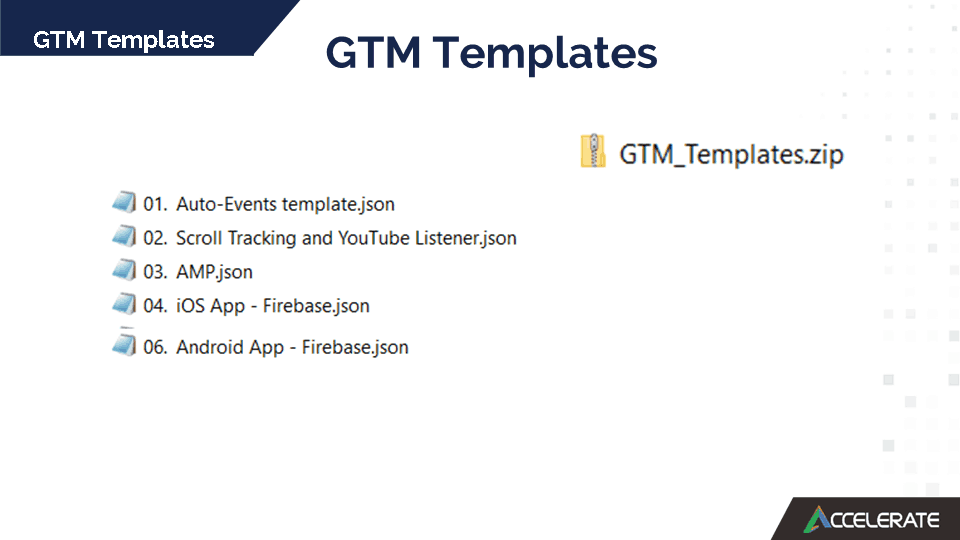
And you would get a bunch of extra things, like scroll tracking, video tracking, etc –– things you wouldn’t necessarily see but you can capture. Having kind of better visibility just means then you’re going to be able to make better decisions, you’re going to be able to remarket to people, recapture them and understand their user problems as they’re trying to traverse through the website or trying to convert.

[00:49:58] So that in addition GTM bots examples, there are some other ones which are in a library here, which you’ll get access to. So for instance, if the website is on iOS or Android or in Firebase, then you can automatically plug in some Lego and it’s just kind of pre-setup for you. Or if it’s on –– if it’s one of these types of sites –– then you will plug in a bunch of other stuff that similar types of sites have used that you probably may or may not need.
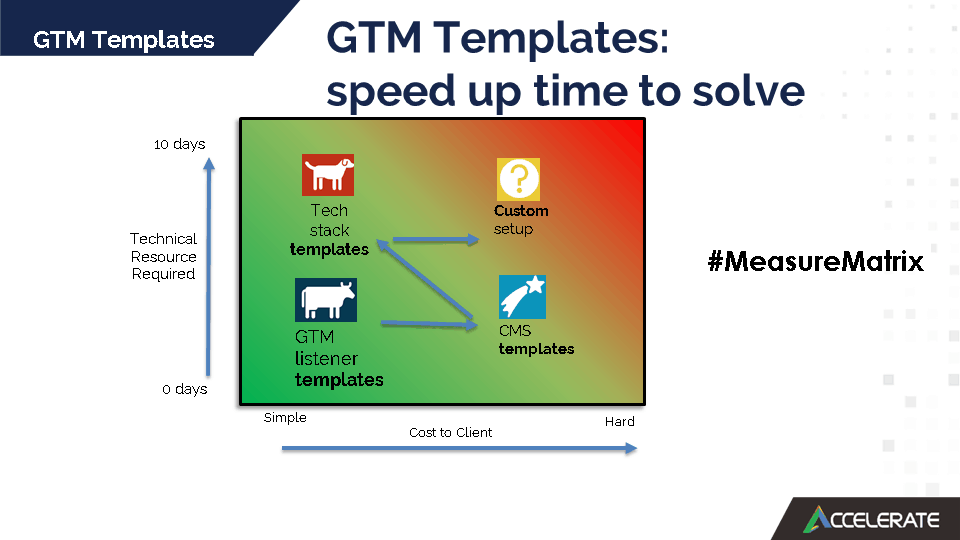
It’s great for just rapidly scaling and rapidly setting up an account because you’re literally running a Lego building mode. And there’s a whole framework for getting, speeding up that setup and data collection can at least the end goal would really be to get to being able to A/B testing, remarketing, and understanding users much better. And using that data to improve your marketing performance.
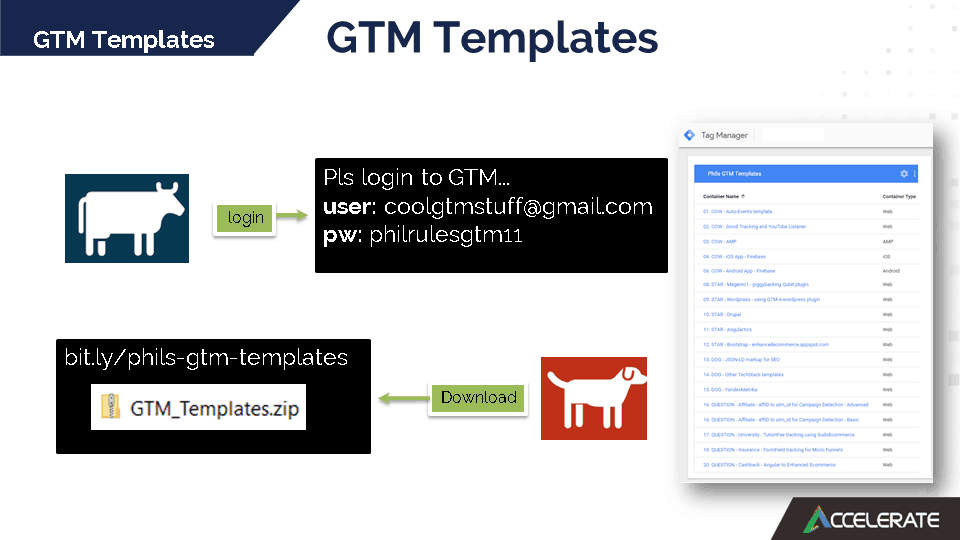
[00:50:45] The templates you’ll get later.
That’s most of what I was going to cover on these sets of slides. We have so focused on some technical tips here and because –– and some of this you will and you can kind of go away with and have a play with later. As I said, everyone will get a copy of the slides.
We probably got time for questions.
Q&A WITH PHIL AND NICK
JACK: You’ve got five minutes for questions.
[00:51:08] Okay, so do the two of us stand up? Okay. [Nick joins Phil]
Have you got any questions for either myself or Nick?
[00:51:20] QUESTION: How do you suggest basically analytics across the website and
App, so… cross-domain and tracking –– and would you recommend a separate analytics tool for your SATs product, that’s gonna give you that detail or do you use Google? Because we ran into some problems at the minute where we have sampling issues with the quantity of users we have. We’d have some inaccurate metrics. What would be your recommendations –– specific tools or carry on using GA?
[00:51:51] PHIL: There’s a new –– well, first, are you logged in or not logged in? Excellent.
So it’s kind of a bit like your Facebook, as in everyone’s got to authenticate and log in. In that situation, you can use the User ID sessionizing feature, which means normally on Google analytics, when you land on a website it doesn’t know who you are. It just randomly creates a number and a cookie and stores it in the browser. If you’re locked in, you can say –– no, don’t use that random number, use the number I’m giving you –– you’re 007, you’re 008, etc. –– and as you log back in, it says –– Oh, hi again, 007 –– so that’s a much, much better way of recording logged-in users. Additionally, Google have rolled out App + web recently, which is an even better way of doing it because it has –– if a logged-in is not present, it then falls back to a cookie. So switch to App + Web if you haven’t already.
Regarding sampling –– and I had this on a large betting website, which was doing kind of frequency updates of every 30 seconds or so. I mean, you can do client-side sampling. So you say only 10% of traffic or 10% of page views. And then times it by 10 on the other side. There are ways around it, so you can hack the free tool to your will. I haven’t yet found anything that hasn’t been able to solve regarding both sampling or User ID tracking. The only problem is more when they’re not logged in and you get an issue with Safari, for instance. But yeah, there are ways of doing it.
[00:53:24] JACK: So a couple more questions, anyone else? Questions?
[00:53:34] QUESTION: How do you recommend someone that is trying to reach quite a large international audience –– but with quite a niche product –– we’ve been going at SEO with some success in the UK, but it’s quite difficult to reach that niche out of the UK.
[00:53:34] NICK: So you’re trying to reach a market globally –– you’ll obviously need to look at your customers again, look at the customer personas and do customer interviews. And then obviously find out where those people hang out digitally. What online publications do they use? Do they use review sites? What do they actually do? Then you obviously want to have your website/products, actually, on that website –– yeah, and also that will help you rank for your keywords.
[00:54:25] QUESTION: What about language?
[00:54:28] NICK: Language –– it depends obviously. You seem to have you have content which is likely to make sure content is in that language of that country. You can obviously –– there are quite a few things you can do. Best is to use one top-level domain –– .com –– then obviously you change that to a “.fr” or “.uk” and so on and so forth. So catering for the language of that country and that obviously reaches the sites of that country.
[00:54:28] PHIL: AVG has a very good example in terms of an optimal setup of an international site for SEO. They have a top-level domain of AVG.com and it’s folderized by language –– and also has direct lines and everything, so that’s a cool best practices example.
[00:55:17] JACK: Anyone else?
[00:55:17] QUESTION: Can I just ask Nick? You were talking about in the metadata for the content –– and how it’s really good to have things like (we are the) #1. What’s the downside of that, if you’re not, you know –– how are you keep making those claims and is there any kind of authenticity checks or anything like that?
[00:55:49] NICK: That’s a good question –– yeah.
[00:55:54] NICK: On Adwords, there are –– we need to support anything. So if you make a statement about yourself or competitors, you have to have one click away from a landing page. You have to have a third party that supports it. But for organic, there are no rules that apply in that sense. The only exception would be with review stars, where you have to be genuine. If you’ve got 5 out of 5 stars, you have to have actual reviews to support it. And so ––
[00:56:20] NICK: With metadata, there’s quite a lot you can do with it. This is about standing out. So you can use capitals, which you can’t use on AdWords as well. So you can really stand out –– if you’ve got a free trial, you can put that into your metadata as well –– in capitals. And “click here” is quite useful as well with little arrows.
[00:56:41] JACK: Okay, thanks, guys. We’re here until 12 and Phil can follow up afterwards.
Thanks, guys –– lots of deep knowledge bombs there. So hopefully we’ll all keep up. And we can have a short break now, five minutes –– bit of a caffeine top-up, toilet break, whatever you need to do. Please be back on your seats ––
[Workshop goes on a break]
PANEL DISCUSSION WITH NICK SHAW, VINNIE MORGAN, ANDREW JACKSON
[00:56:56] JACK: … for London, NHS, greeting Brewers and Microsoft. So he’s selling software to software companies –– that’s good. Vinnie started out as a developer, I believe. He’s been MD of a digital agency, and now CEO of BookingLive.
[00:57:10] JACK: And then at the end, we’ve got Andy Jackson. Andy is the Entrepreneur Acceleration Manager at NatWest Accelerator here in Bristol. He runs the team –– they provide support for startups and scaleups across a number of programs. So if you are looking for business support for your startup/scaleup, talk to Andy. They have some great, great programs they’re running at NatWest. And Andy is very varied spending time in the British Army –– and then most recently working as a consultant, coach and trainer for business owners and teams. He also had a stint, helping to clear mines in Kosovo and Somaliland –– which is very impressive. Interested to hear about any transferable skills there.
[00:57:46] JACK: So let’s start –– I’ve got a question for you Nick –– I’ll sit down a second. Nick, you’ve seen some stuff that Accelerate are doing, I’m interested to know what you would consider the most interesting digital marketing trends in 2019 and how you plan to take advantage of them.
[00:58:01] NICK SHAW: So if you look at some of the digital marketing trends that the one that people keep screaming about is hyper-personalization –– and making sure what the stuff you were doing online is relevant to people looking at it. And what we’re trying to do more and more is to make sure that anything we serve to people –– whether it’d be PPC ads, whether it’d be anything –– is relevant to their company and making sure they fit within our ideal customer profile. Because one of the challenges is we get a lot of leads that are not aligned with customers. So what we’re investing in now is understanding –– we spent a lot of time working out what our ideal customer profile is. For instance, we know it’s 10,000 customers.
And then every time we’re doing PPC, we’re making sure those adverts are served to people who are from those companies, at different times. And therefore, we’re trying to just reduce the noise we’re getting and just improve that slightly. That’s what we’re trying to do as much of as possible. Because it, you know, we run as many of you probably do –– we run through marketing qualified leads to sales, qualified leads to sales accepted opportunities, the standard kind of stuff. And just –– if we can increase that in all the different areas, it really makes a difference in terms of the number of sales we all to make. And that’s what we’re trying to do. Because there are loads of exciting things but they’re not as relevant to us in a very –– because there’s a lady over there who said she’s in a very niche market. Let me tell you, being in a retail market, which is in a specific area of retail, is very niche. And therefore, you’ve got to be hyper-personalized in what you’re doing.
[00:59:39] JACK: You talk about these different leads –– I think, maybe for some of the people working in smaller companies – can you just run through this very quickly [crosstalk] what you mean by ‘different types of leads’. ––
[00:59:48] NICK SHAW: Yes. So what we do is we work out that –– what we have what’s called a marketing qualified lead, which will generally be like someone’s filled out a form on our website and they would like a demo or something like that. We don’t immediately give them a demo. And we will get one of our PDR team to ring them up and qualify that out. And then from there, that will move to a sales qualified lead. And we may do a demo, we may not do a demo –– but what will have is something called a discovery call. So we’ll go through two stages before they even have the demo from us.
And from that discovery call, if we’re comfortable, but we think there’s an opportunity there –– just budget –– and we run a sales process called MEDDIC. If you look it up on the internet, it’s a very good way of unqualifying through things to make sure before we accept it –– and then it’s called a sales accepted opportunity. That’s when it goes into what was called out forecast and we expect ––
[01:00:38] [Video jump cuts to later]
[01:00:40] VINNIE MORGAN: –– on the privacy, where it’s just embedded and we don’t of it as a consumer anymore. Once we get through that –– customization, you know. Thinking about VR, AI –– thinking about all those contemporaries today having all those apps relevant to you and the next person having apps relevant to you has to be quite exciting. So yeah, definitely that’s where we are today –– virtual content –– all relevant. Once we get through data, I think personalizations really going to take off.
[01:01:04] JACK: And you’ve got three different audiences effectively –– three quite different audiences as well: public sector, enterprise, SMEs. So you got to affect three different types of campaigns running, personalizing for those people. How do you treat those audiences differently with your digital marketing?
[01:01:21] VINNIE MORGAN: Yeah, definitely. I have more heads now, I’ve got Jason here from my marketing team as well. They are very, very different.
If you think about SMEs –– they want it there and then. They want it on demand. They don’t want to wait for a personalized demo. We’ve just described that and that’s perfectly true for enterprise clients, certainly for the public sector.
Clients that buy-in cycles are all slower. The public sector wants to do their due diligence a lot more. They want to see your financials, your accreditations, your processes –– SMEs they don’t want to know that. They want to see the product. Is it user-friendly? Can I use it now? Can I generate revenue now? Who else is using them? Very, very different by insight –– and we need to optimise that and get them on board as quickly as possible.
As Phil was talking about the sales cycle funnel – it’s critical and using tools like that really do help with the SME sales journey. The public sector and enterprise are very, very different –– and public sector, in particular. If anybody here is thinking of selling into it – it’s a time-consuming task. They’re not going to do it today. They will do their research and it does take you a long time to, I think I just mentioned, to get you closer. Very, very different sector.
[01:02:25] JACK: Andy?
[01:02:28] ANDREW JACKSON: I’m not technically-minded in whatever shape or form, so the majority of Nick and Phil’s presentation just went not there –– it is like THERE [points far above head] for me. And so my perspective is very much around who is your customer. And it is great actually that one of the things Nick put up first was –– when how many people have interviewed customers, how many people have talked to customers, how many people have interviewed them when they were potential customers? That would be my take on this. These tactics are absolutely valid if you know your customers well enough to apply them meaningfully.
[01:03:02] So my question to you would be –– when’s the last time that you interviewed your customers? When’s the last time that you actually talked to each of those individual niches –– and that can establish really clearly that you are addressing the problem that you think that they’ve got because the customer does change. The market changes and everything that you need to be delivering will, therefore, need to change. You’ll only know that if you’re constantly getting that feedback from the customer.
[01:03:28] JACK: Basically, that was the question I was going to ask you so –– happy days.
ANDREW JACKSON: Happy days.
[01:03:31] JACK: Because you’re working with people that predominantly who are just starting out. So they have an idea or they might have built a very early iteration of their idea. And they start to take that to market. So is there any other advice you find yourself giving on a regular basis then, when they are thinking about their audience, when they are thinking about building out marketing campaigns, or building out a marketing strategy in the first place? Any other sort of tips or tricks or tools that you use –– any kind of advice you find yourself giving them?
[01:03:53] ANDREW JACKSON: So just to be clear –– yes we deal with startups.
But quite a lot of the business we deal with on a more regular basis are well-established and, you know –– a number of the businesses in the Accelerator at the moment are very multi-million-pound business. So these are very scalar orientated.
[01:04:07] Without exception, the conversations that we do have with them are: Who’s your customer? When’s the last time you did customer discovery? And then have you got a marketing strategy? What is it that you’re actually seeking to achieve? What is your long-term strategy, vision, goal for the business? And where it is that you’re ultimately going?
[01:04:28] And often the person who’s leading the business or the person that we’re talking to isn’t necessarily the right person to develop that strategy. So we’re saying right: who do you know, who can you speak to, who’s got the geek ability that will really drive this. So put it in place in the right kind of way, so that you know that you’re delivering the right kind of marketing to the right kind of market.
[01:04:48] So that’s definitely around who is it that you know or who’s delivering that strategy? Who’s developing that strategy so it’s going to be meaningful.
[01:04:58] JACK: Vinnie, going back to your point about the different audiences, obviously, the process is different for each of them. You do have a trial, sort of demo –– is it, say –– how do you handle that handover between digital engagement, if you like, and then the real-life conversation. What’s the kind of process for when someone signed up to a demo on your site –– how to do you take those leads and turn them into real conversations.
[01:05:21] VINNIE MORGAN: We follow exactly the same process described by but again, you know, we focus on the three different ones.
So SME, they want it on demand. They want it there and then. Yes, they can sign up. They can view videos. It needs to be short and separate videos. These guys want to, in reality, they’ll try and find six different options before they commit. And so you need a really good UX –– you need to remove any potential barriers in signing up forms are limited. The email get sent straight away from a third party distributor –– SendGrid –– a great, great company, by the way. So one click logs them in automatically.
One of the key KPIs we sent the dev team when we were building this product –– we only launched in March this year, by the way. And this has been, in terms of organic growth – it’s been fantastic. I’ve worked with Nick and Phil and the team on that strategy. We’re selling in 50 countries worldwide, fighting for customers. In less than 12 months it’s doing really well.
This is so important to get that signup conversion –– and actually for customers to complete the whole cycle to be taking revenue within five minutes of initial signup. That’s a key metric for them to follow. And the one crop up is that they didn’t have a strike account. So assuming they have a strike account, you can actually do that. Getting that optimisation as slick as possible –– and just giving them added value and tools as automated as possible is critical.
The public sector is all about the demo. It is all about case studies. They’d even speak to all 414 authorities in the UK. They all speak to each other. And if we have one bag egg, everybody will know about it. So you’ve got to be on top of it. It’s more than just a sale cycle at that point.
For us, we’ve recently changed our business model. We’ve removed our setup fee, which might sound crazy – our average setup fee is around £25,000, a similar kind of model to Brightpearl. We’ve now got rid of that and we just pay, in terms of our sale cycle, on day one earned. So our annual fees have actually gone up]. And we changed it to modular pricing. Our clients get it and they liked it. For us, we get to cash in on day one, rather than wait maybe 90 days for the second invoice, which is six months down the road, to get paid. Our cash cycle has improved massively.
For them, it’s much easier –– because they know what they’re going to pay year on year. We’ve removed all limits around transactions, we run support, they’ve got 24-hour access to account managers, etc. So that model is completely different from the SME model. I could talk about it more, but the enterprise and public sector are very well aligned. SME completely. I’d be happy to chat with anyone further about this after the presentation.
[01:08:00] JACK: Is there anything you can point to that’s particularly changed in the last five years? In the sense –– is it the way they engaged with you changed? Is it the way those sales conversations had been initiated? Has anything particularly changed in the last few years?
[01:08:11] VINNIE MORGAN: Quite a lot. Again, if you look at the public sector, you’re going from traditional five-year contracts down to two plus one. They’ve changed the procurement process, they now have them engaged in frameworks. In order to get on those frameworks, there’s a lot more attached, where you’ve got things like GCloud, you’ve got DOS, you’ve got products and services and these three different tiered frameworks within the public sector. They’re very difficult to get on so you need your accreditations and case studies, etc., to do that.
SME, with social media, in particular, what it has given them is a voice. You have one bad customer and that would certainly bring your average ratings on Google and Trustpilot right down. So again, you’ve got to get the right targeted customer to make sure that the product is right for them.
And we’ve had to do a lot of that sort of implementation where you get one idiot or customer that you’re working your butts off to try and make successful, regardless of all the costs – you want to make them successful. We have one broken priority and they leave a bad review and it has a ripple effect. So you’ve really got to keep on top of everything. And marketing really isn’t just about acquisition, it’s about retention as well. So again, very different between SME and public sector, but – a lot to think about.
[01:09:15] JACK: Nick, same question. Anything that you’ve seen in your space with retail markets changing?
[01:09:22] NICK SHAW: I think in the SaaS market, there’s been a massive change in the last five years. If you look at the net promoter scores for most SaaS companies have been going down, customer expectations have been going up, prices have been generally going down for the products, and PPC or any marketing cost have been generally going up. So it’s kind of like a perfect storm for most SaaS companies.
And what they have to do is they have to find better ways of marketing. There has been much more of a shift to customer success. And you’ve seen a lot more Saas companies implement customer success. We see that as a key thing, making sure customers are happy with us. We look after them. So it’s more about looking out to them. And I think five years ago, people weren’t so bothered about the long-term journey with the customer. But I think there’s been a shift generally in the market where –– because it cost so much to acquire a customer now, even much more focused on holding on to that customer for as long as possible –– and really looking after them. Across the SaaS board, you’ve seen the kind of companies like Gainsight. People focusing on the long term because, you know, customer acquisition costs go way past 12 months. They have to hold on to them for as long as possible. So there’s been that kind of massive change.
[01:10:41] JACK: So you think this –– the customer success, to be specific, that’s a team in your organization responsible for delivering success for your clients, helping them. Give some examples ––
[01:10:52] NICK SHAW: Yes, so what they do is –– obviously, when you buy, you know, a retail platform –– you go through implementation. And by the end of implementation, you move from a –– what’s called –– a professional services team to a customer success team. And they’re there to make sure we have Technical Account Managers who are technical people who will help you. Because when you buy a product, people leave the business or people have niggles and stuff like that. It’s about making sure the customer journey is as good as it possibly can be. During that initial first year period, you find that the use of the Technical Account Managers, kind of, dwindles slightly after the first six months –– they’re going through those pain processes and stuff like that. But it’s still important for them to have access to that because it allows them to solve problems and stuff like that. And key –– you know, for us, it’s about keeping them as happy as possible, using a platform, gaining the maximum amount of value. And that’s why we have that team.
[01:11:42] Since we’ve implemented that team, our churn has massively reduced, and we’re seeing our upsell with existing customers massively go up; so, it’s really made the difference. And that’s across the crowd. You can see many, many instances in cloud companies that are putting customer success teams into the benefit of them.
[01:12:00] JACK: Is that something you have in place, Vinnie?
[01:12:03] VINNIE MORGAN: Yes, we went through a process actually about 12 months ago, merging traditional project managers and account managers into one role. It’s challenging for people in a consistent role, but for people brought in externally, we’re alright as it’s very common in the tech scene for customer success. We’re still going through that process. We’re still trying to change the ethos in the business to be –– traditionally, the customer wants some training, let’s bill them, then wait for the invoice to get paid 30 days later, then let’s go visit them. Suddenly the customer’s forgotten what they wanted and then it’s a horrible customer journey. That’s something we’ve taken into account with our new billing.
And our team really just focus on conducting and reaching out to them, offering them by showing them new features, what our competitors are doing well – where we are going for our events? Should we meet for a coffee? And trying to give them as much added value, and training is just part of that. So they now make the decision – do we need to visit that client on-site? –– is that something that they will get value from? We’re heavily expanded as well, we’ve just closed another VC round. So we hiring a lot of people and if there are any other customer success roles (professionals) out there that people are aware of, then send them our way please because we have to have them to scale up.
It’s just one of the many things, It’s a very, very fast industry. It’s one of the things that we’d be happy to see more of.
[01:13:21] JACK: Andy, in your world, are there particular resources for figuring out professional development in a clearly fast-moving world. Especially in SaaS where people are at the forefront, developing new tools – everyone’s being disrupted by someone. Are there any particular resources you’ve found yourself directing your mentees from a professional point-of-view?
[01:13:47] ANDREW JACKSON: Short answer is there is no one thing that will suit all. That’s the approach we would recommend to anybody seeking professional development is to find out what it is that you need and then work with that. If there is a specific technical skill that you use, find that technical expert that is definitely going to add value in the way that you need it to add value. The majority of the people we work with are those individuals within the business who find it quite a lonely place to be and they need a sounding board. They want somebody to talk to. They need a community of like-minded people to be able to bat those ideas off.
[01:14:27] Vinnie, you were talking about earlier about a community that you are in. And you found it so really powerful to have people that you can open up to in a confidential but meaningful way, that allows you to be able to problem-solve, access expertise, get referrals, other people’s contacts and networks. That’s the thing that really makes the difference. The majority of programs that deliver a specific outcome –– that will be that outcome. In organizational and individual development terms, it is absolutely in –– to my mind and certainly NatWest perspective –– is around the community. And it’s about networks. It’s about opening those contacts so that you can access the relevant expertise to grow in the way that you and your organization need to grow.
[01:15:20] JACK: Thank you. You mentioned there about networks and connections and things. I was wondering whether, Nick, you have any samples where you formed strategic partnerships as part of your business life, where BrightPearl, like, could be in a previous life where you formed strategic partnerships with other SaaS or other business and community. And give examples where that’s worked well with you before.
[01:15:34] NICK SHAW: Yeah. I think the first thing with the strategic partnership, I always think, is it’s going to be a win-win for both sides. And I think people sometimes forget that they go –– well, they’re giving me leads and I’m giving them a bit of commission. So, therefore, that’s a win for them. You really got to understand if you want to have a strategic partnership what both sides want. You got to make sure that aligns with what both of you are trying to achieve. So often, strategic partnerships fail because one side doesn’t understand what the other side wants. And if I look at the discussions we’ve had –– we were looking for an SaaS SEO agency. We went out to multiple agencies. And the thing for me was to make sure we understood –– that the agency understood what we want, but also we understood what they wanted as well. And make it a win-win partnership. If you don’t get a win-win partnership, it’s not going to work –– and that’s a key thing for me.
We looked at many agencies and we chose you, guys, recently –– and it was because you understood what we wanted. We understood what you wanted. And we found a win-win relationship. That’s the key thing with any strategic partnerships. When we have –– when we work with agencies –– or when we work with other software providers or other SaaS companies –– the key thing I ask the team is what do they want and is it aligned with what we want. Because it doesn’t, don’t work it –– and we’ve had one where we’ve looked at them and gone –– what they want is not what we want. There’s not a trust level.
[01:17:06] You know sometimes you have this thing called coopetition, where you may be working with a slight competitor and there’s not a trust level. If there’s not a trust level, don’t work because there’s going to be problems. If there are problems –– and there’s going to be problems with partnerships –– the key thing is to be open and honest and have that discussion with people when there are problems. And you know, I’ve worked in many companies, where salespeople have done the wrong thing. If you’re honest and you say –– look, we need to sort this out, we’ve made a mistake –– generally, you’ll find it will go a lot better than if you just hide away from it and wait until they find out. And that’s being my thing, if you’re open and honest and have integrity, you’ll find partnerships that will work.
[01:17:50] JACK: I’ve got to say it’s a pleasure working with you, Nick, on the basis that you were honest from the outset. We’ve been nailed to the floor by clients far too many times for my taste. It was refreshing.
[01:17:59] Vinnie, you have any examples of strategic partnerships, whether at BookingLive or a previous role where it felt you’ve generally grown as a result of the partnership that you’ve had. It doesn’t have to be agencies, suppliers –– it could be other people.
[01:18:11] VINNIE MORGAN: I’ll just, first of all, echo what was Nick was saying. What you guys have seen here today –– and content-wise. That’s gold-dust. You pay a lot of money or you can waste a lot of time. We’ve paid a lot of money to get to where we are. To get that knowledge which has then been embedded in Jason and the rest of the team. And you’re very fortunate.
And if you are in a position where you get to work with these guys – I’ve been in this sector all my life and ran an agency for twelve years – they are the best. They are techie geeks. I hope you don’t take that in a bad way. That’s a very good thing. Those are the guys you want on your side. So thanks for a great presentation, by the way.
Down to the question, yes we do. And we work with a few companies. There’s a lot of resellers in the public sector. What we are new to –– as I’ve said earlier, our products only launched in March this year. So we are new and probably –– hopefully –– following in the footsteps of these guys (Brightpearl).
We are new to setting up those frameworks and resellers. And Nick is exactly right –– it doesn’t need to work both ways. Again, the public sector is one of our key strategies moving forward in those partnerships –– not just with suppliers but with people you could cross-sell services with as well. And it worked very well for us the onboarding –– not only the acquisition to sell our software into that client and into that market which is what the partners do. But the actual onboarding as well and educating them about how it works and what the best solution for them is. That is for us to train and hold a workshop and that client then goes out in that kind of
[01:19:51] JACK: I got a couple more questions to the floor. I’m a big believer –– in learning from your mistakes. So I was wondering –– if you could share and you don’t have to be specific –– but share an example of something you did wrong and you feel you could have done better. Keep it related to work and needs to do with marketing. Just to keep on track.
[01:20:10] ANDREW JACKSON: My mistake is not understanding the motivations of somebody else when going into business with them. There was a –– I’m not going to use names or specific scenarios. However, I went into business with somebody and invested quite heavily in a particular project. And this particular individual wasn’t on the same track as me. I thought they were. So I didn’t do the due diligence in terms of understanding what the partnership was all about. What it is we were seeking to achieve? What the long term thing was? I was just really excited about that particular project. Long story short, we weren’t aligned in the way that we operated. So actually, in terms of what we wanted from day to day didn’t work in the way it should have done to be successful. And I lost a lot of money. That was a lot of things wrapped up in that in my personal learning. But yeah, that’s certainly guided some of the things that I now encourage other people to think about.
[01:21:17] JACK: You have to get through these things, I guess, to need to learn.
Nick, anything you’d like to share?
[01:21:21] NICK SHAW: Yeah, I think, in a previous role sometimes you –– look, and I was running a security business. We sold our products in one, five and ten batches. And I believed in the way you take promotions work in retail is you can only promote for six weeks. And that product has to come off promotion and you promote another product. I believed that if we dropped our –– our biggest selling product was our five-user product. I believed that if we dropped our ten-user product to the same level as our five-user product during the promotion –– I thought that when we had to take our five-user product off, that our sales would be similar.
I learned that consumers are very complex. And actually, our sales fell through the floor –– even though that product was the same price and consumers are getting a better thing. And what it taught me was don’t have eyes when doing things, meaning when you do pricing –– we did a lot of price testing in my previous role with consumers. And what you think they’re going to do and what you might think might win when you’re doing A/B testing quite often doesn’t.
So just have an open mind and do a lot of testing and do a lot of things and learn from those things. I’m this saying with the team: Fail fast. Learn from those mistakes but try things, admit when they’re not working, and move on and try something different.
[01:22:39] JACK: Vinnie, anything to add?
[01:22:40] VINNIE MORGAN: Again these guys echoed exactly my thoughts.
So, anyway, you’ve got to be decisive. You ‘ve got to be tenacious –– across your entire business and not just in marketing. But you know, the fact that you don’t know what’s going to work until you try it. That doesn’t mean you can spend a lot of money, we’re going to waste a lot of money. You could, on reflection, say that was an error and a mistake. But how would you have known that was a mistake if you didn’t try it.
We’ve spent a lot of money on social in a B2B market –– it didn’t work for us. It might work for others, but it didn’t work for us. So we stopped that and we’re now dipping our toe back into LinkedIn advertising and other opportunities out there. But unless you make those mistakes, you don’t really know. So don’t be afraid to do it. Equally, if you keep your budget relatively small, it would not probably hit enough of a demographic to give you the true results.
And, one last thing is, have metrics work or KPIs –– whatever you need to track and measure the success of these marketing opportunities. That’s so important.
[01:23:44] JACK: To finish on a positive note – I’d love to know if there’s something that you just absolutely nailed from the initial idea, to planning, to execution.
JACK: There must be something, surely.
VINNIE MORGAN: That’s hugely successful? Anybody?
JACK: It could really be specific –– a tactic, a strategy for the business. It could be –– something ideally related to digital marketing.
[01:24:03] VINNIE MORGAN: So for me, there are four key things to success, regardless of what position you’re at with a business: that’s strategy, people, product and execution. If you can get that – and cash is obviously the fifth one. If you can get those four things right, you’re probably going to be successful. For every key decision, we make on board level, management level or wherever –– we always have those four things in mind. Is this driving the product forward, is this driving our revenue, is this improving our people – that kind of thing. Those are always the four things we’re looking at.
[01:24:33] NICK SHAW: I think they’re really a good point. The only other thing I’d add to that is: You’ll always have some people who say you can’t do this. You have got to be willing to not listen to certain people who say you will never do this. Just push through. Because you can do it and you will achieve it. That’s the one thing I’ve learned is –– you know, you gotta have that in your mind. Just keep pushing through, because otherwise, you’re getting nowhere. Because there will always be people who say you can’t achieve it. And you may not get all the way there. But you’ll get a good percentage there if you keep pushing towards it.
[01:25:07] ANDREW JACKSON: So one of the success stories that we like to shout about is –– does anybody know Brian Allen from Rovco? So ROV underwater recording and he’s disrupting –– they are disrupting the industry, the oil and gas industry –– at the moment –– with 3D digital imagery.
And he came into the Entrepreneur Accelerator with just going to be a service provider. He was going to be the guy who was the operator on the surface, operating ROVs. And he says, if you want to be disruptive. It’s not going to work. You’ll just be another service provider in a very big industry. So essentially, we challenged him quite hard into his thinking: Is he going down the right lane.
So how far do you persist to the point you were you actually have to think differently about what it is that you’re doing? We challenged him quite hard. And he basically, we said –– if you want to carry on down this that’s fine, but you’ll never have the business of the lifestyle you are dreaming of. So this big organization and big thinking.
He came back a couple of weeks later. He said –– well, I’ve got this thing that I’ve been playing with in the back of my mind and wondered if this might be interesting. Cool. He’s basically built his business on the back of some really disruptive 3D imaging technology that is completely remote, that is going to massively disrupt the way that the oil and gas industry that looks after their underwater assets.
And he went from basically a man with an idea –– I think they’re looking at their series being around sometime next year, going for tens of millions of pounds of investments. And that’s in the last two and a half years.
I think the point from there is don’t be afraid to challenge your thinking or the thinking of those people who are around you. Is what you’re doing the best way to achieve your overall goal?
Just to echo something that these guys have said in terms of the things to focus on, for me, it is: What’s the vision? What’s the strategy and the plan to achieve that vision? What’s the infrastructure that you need to be able to deliver it? So who is actually going to deliver it –– people and cash. And then it’s just the implementation –– execution. Every time.
Vision, strategy, people, cash, implementation –– go for it.
[01:27:34] JACK: Thanks, guys. So that’s all my questions. Lots to be here, wondering if anyone’s got any questions for the panel. We got another, sort of, five minutes for a few questions. Back there. Are you alright, just to shout out?
[01:27:34] QUESTION: You mentioned that social didn’t work for B2B marketing. Are there any strategies that you’ve found are pretty good for B2B specifically?
[01:27:57] JACK: Just to clarify, you would like to hear strategies for social media marketing –– for B2B?
[01:28:04] QUESTION: Not just social media. Just in general marketing for business to business.
[01:28:08] VINNIE MORGAN: Yeah, sorry to keep plugging the marketing team. But they’re the guys to speak to –– drop us an email after so we can have a conversation and go through more detail. There’s a lot that we do. A lot of activities. Social hasn’t worked for us but that doesn’t mean it doesn’t work for anyone else. For resellers, in particular, across the business, not just in acquisition. We’ve invested in our customer success team, so we’re focusing more on retention –– again that lifetime value and making sure that the reputation of the business is likely important. Especially now that we’ve launched the SaaS product under the same brand. It’s a very nerve-wracking thing –– to think that potentially we’ve got hundreds of customers out there. We don’t know who they are. We don’t know where they are. We don’t know what they’re doing with the product. You know a few bad reviews could have a really bad effect. We’re trying a few different things. Jason is there anything in particular with B2B that you can remind me about? Yes, there’s one in particular –– the one that generates the leads from visitors on the site. No, not that one… I haven’t answered your question very well. Let’s have a chat after and organise a conversation.
[01:29:20] JACK: Cool. Anyone else?
[01:29:24] QUESTION: You mentioned early on about proper hyper-personalization, can you give me as an example of use cases and how that’s worked?
[01:29:33] NICK SHAW: Sure. What we’re doing –– as I said, we have 10,000 ideal customers in the US. And what we’re doing is when anybody from one of those companies goes on to LinkedIn or other sites, that’s being served now. It’s not perfect because we can’t –– we don’t have all the data on those companies. But it is bringing us –– and I went through it earlier –– it is bringing us MQLs and SQLs from that customization. That’s not hyper-personalisation because that’s more, I’d say, on the edge of account-based marketing rather than hyper-personalization. Because hyper-personalization is, as Vinnie said earlier, walking past Bristol Temple Meads and giving you an offer on a train. Or walking past a Costa Coffee and giving you that. With that, hyper-personalization is more B2C rather than B2B. It’s a little bit more tricky. So I think in B2B SaaS, it’s more account-based marketing and just marketing directly to the accounts that you’re targeting or the customers you’re targeting. That’s how we’re doing. It’s not perfect.
[01:29:36] JACK: Anyone else? Lady in the front here ––
[01:30:38] QUESTION: How much value should you give away before you start charging?
[01:30:51] JACK You say, how much value should you give away before you start charging?
[01:30:52] QUESTION: Yeah.
[01:30:54] NICK SHAW: I don’t think you should give them anything –– because people value what they pay for. So we charge from the first day they take our product. You have to because otherwise –– but there are some certain products where giving them an evaluation for a short period does actually bring them over the line. So certainly in our customer success teams when we’re upselling, we may give them a certain amount for free to get them to take our product. Because they’ve already got, for instance, modules of BrightPearl. And we may give them another module to test before that. There’s no right or wrong answer, but the longer they have –– you’ve got to give them a compelling event to move them off it. Because if you give them 30 days or 60 days, you got to make sure they’re going to get some value from it, that they see value in the product during that period while there is something. Because if they don’t use it, then you’ve given them 30 days for nothing.
[01:31:46] VINNIE MORGAN: Yeah, I’d like to say for me, that the traditional freemium models are dead. You limit by features. You limit by trial. You limit by user licenses. That’s just restricting them and annoying the customer. And that’s not what you want to do. Be very clear with your pricing, regardless of the size of your enterprise, from day one. And value the product, be proud of what it is. And if you’re new to the market, you need to build up some case studies and you need to offer them an incentive to do so, then do that. But don’t undervalue because we’ve actually gone through a pricing change/pricing increase for the first time in seven years. And it’s not very well received. And our customers are like –– we can see why you’re doing it, we’re going to pay you, but were pretty pissed off when we’re paying such a big jump. It would have been better to have implemented or done something different over the years. We’ve had to do it. Because we have removed all of these limitations that we’re in the software. But, I think, stick to your price and don’t undervalue. And be very, very careful about if you do the freemium route, which of those options you take.
[01:32:47] ANDREW JACKSON: For me, it would be all of those things that set some really clear expectations of what it is that people are signing up to. So if you’re going through that purchase process going to the engagement process, then yeah. But you make it really clear that this is the route that we’re taking you down –– to the point where we’re going to ask you for money. Or are you going to ask them for money now and then we’re going to take them down this route. And that supporting them through that journey. And people are more than happy to engage or not –– then they’re not customer anyway.
[01:33:18] JACK: Thank you. A couple more questions? Have we got a couple more –– a lady back there.
[01:33:29] QUESTION: This is not a question really. I’m in the B2B space as well, and it’s really difficult. And so I think some of the stuff that you did earlier, the way you used several different tools to –– so, for example, our customer base is very varied. Finding an ideal customer profile is very difficult. So that you spread your money very widely and very thinly and it becomes difficult. Understanding what they (your customers) are reading and where they’re reading it is very difficult these days for a broad customer base. So using some of the tools suggested earlier where you’re trying to filter down and use LinkedIn at the end for outreach – I’d also say that from a B2B point of view, I’ve been around the block. I’m 44 years old. I’d say don’t be afraid with old school marketing. So, attending events, direct mail. If you want to go after a certain local area, the post office do a service where you just choose a postcode and door drop those cards through the front door advertising your business in that area. So I’d say bear in mind what you’ve talked about this morning, but don’t be afraid of old school marketing.
[01:34:42] ANDREW JACKSON: Yeah. If I can add to that. That echoes a couple of thoughts I was having earlier in terms of digital –– what you were saying guys in terms of digital marketing, SaaS marketing, whatever it is –– is absolutely applicable to some people. Social media doesn’t work for you. Digital marketing might not work for some digital agencies. There are a number of digital agencies that I’ve worked with, where face-to-face networking and word of mouth is by far the most effective way that they do business. Okay? Understand your customer. And B2B and B2C is a categorization. For me, business is P2P. It’s person to person. So the more you can identify who that individual is a hyper-personalization and really focusing on who your customer is, the better you’re going to be able to communicate with them in a meaningful way, such that they will engage with the strategies that you do use. So yeah, that’s my take.
[01:35:35] JACK: One more question. Or two more and I need to close up.
[01:35:36] QUESTION: My question is for Nick. So I’m interested to know if you always ran the MEDDIC approach to the sales –– because that is a reasonably complex approach. How did you transition to that? And then also if you’d manage to automate any of that process to make it more efficient.
[01:35:59] NICK SHAW: So you can run a cutdown MEDDIC because obviously the full is very complex. But we ran a cutdown to –– but we customized to us. Because I think you got to customize it to your needs. Because if you look at the full MEDDIC case: the large enterprise, large transactions with multiple buyers, multiple things, a lot of politics, and stuff like that. So we cut it down to our needs and we’ve taken the steps that we need. Have we made it automated, it’s in Salesforce. The sales team would say it’s not automated because they have to fill it out. I believe it’s automated as it’s ever going to get because you need to fill it out. And the reason it’s really important to have something like that is as you bring new people on and you try and scale, having that kind of discipline will help you scale much better with scales. I agree with you, we don’t have the full MEDDIC.
[01:36:55] JACK: And the gentleman at the front ––
[01:37:02] QUESTION: It wasn’t so much a question, I just wanted to share what we’ve done. So we have spent a lot of time copying what our competitors do and don’t have quite as many resources. If you’re competing in the same space, they’ve got 5 years ahead of you. We compete with half a million other businesses and we’re on an online survey platform. We’re coming against Survey Monkey and qualtrics. Huge budgets. So one of the things I have to do from an SEO point-of-view is create a page that is ‘alternative to survey monkey’ or ‘alternative to qualtrics’. Now we rank just below them in organic searches. This is a great way to get out there.
[01:37:35] JACK: Well, I just wanted to close by thanking you a lot for coming. It’s really good to see everyone here. As I said, this is part of a wider Bristol Tech Festival; so, please do check all the other events. Thanks to our panellist: Any, Nick and Vinnie. Thanks to EngineShed for hosting us. And if you want to get in touch, we’ll send the slides so you’ll have contact details in there. Thank you very much.
END OF TRANSCRIPT
